Uzbekistan
Dusty Stretches Of Nothingness, Unbelievably Hospitable Locals & The Dazzling Islamic Architectural Showstoppers Of The Ancient Silk Road
The Registan, Samarkand, Uzbekistan. March 8, 2015
Uzbekistan (March 4-18 2015)
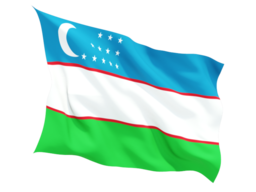 An exploration of the Central Asian country of Uzbekistan, centre of the historic Silk Road, a country full of dust, unbelievably hospitable locals & even more unbelievably audacious Islamic architectural showstoppers.
An exploration of the Central Asian country of Uzbekistan, centre of the historic Silk Road, a country full of dust, unbelievably hospitable locals & even more unbelievably audacious Islamic architectural showstoppers.
Read all postings from the road in chronological order or jump to specific postings using the following links.
EARLY DAYS – Border Crossing, Currency Exchange, & Introduction To Uzbekistan
THE BIG UZBEK THREE – Samarkand, Bukhara, & Khiva
THE CAPITAL – Tashkent
DEPARTURE – A Central Asian Thumbs Up!
The Republic of Uzbekistan
With a population of 30 million, the Republic of Uzbekistan is by far the most populous state in Central Asia, home to nearly half of the region’s 65 million population. It has been the cradle of Central Asian culture for more than two millennia, gathering quite a rich history in the process: Samarkand, believed to have been founded as far back as the 5th century BC, was conquered in 329 BC by Alexander the Great; key Silk Road towns like Samarkand & Bukhara grew wealthy during the trade-heavy glory days from the 6th century onward; Islam was introduced into the region in Uzbekistan by the Arabs in the 8th & 9th century; Genghis Khan razed the country in the early 13th century; the most famous, & ruthless, Uzbek of them all Timur, a.k.a. Tamerlane, was born just south of Samarkand in 1336; the Russians conquered the country in the late 19th century & amid some resistance a socialist republic was set up in 1924; & Independence finally came in 1991 following the break up of the Soviet Union (compared to the other Central Asian states, Uzbekistan generally resisted Russification & emerged from under Soviet rule with a strong sense of identity & cultural heritage). These days the Republic of Uzbekistan is officially a democracy. However, the authoritarian government run a harshly policed state, one that has been overseen since independence by one man, President Islam Karimov. The country, seen as the most corrupt of the ‘stans (& that’s saying something given the competition), is wealthy in natural resources yet, and as one might expect, the wealth resides with only a select few meaning the majority of the country’s gold-teeth populace remain quite poor.
Archived Postings From The Uzbek Road (In Chronological Order)
EARLY DAYS - Border Crossing, Currency Exchange & Introduction To Uzbekistan
Date || March 4, 2015
Location || Tashkent, Uzbekistan ( )
)
Well well well. Today was an eventful day, one of those long, tiring but memorable travel days. I crossed a border (& a time zone), made a new best friend & struck it rich, all the while travelling further than planned.
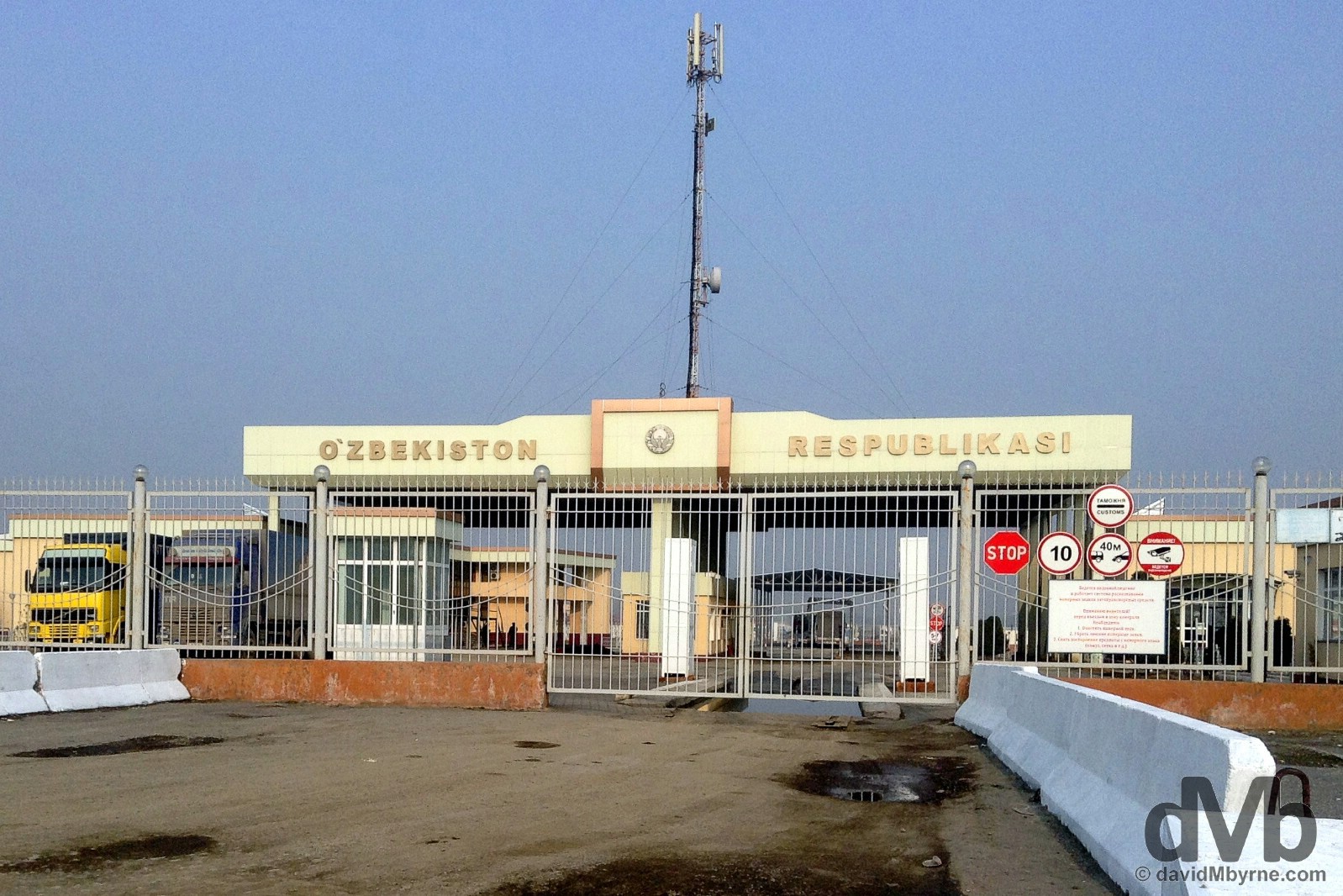
I was at the Dostyk/Dustlyk Kyrgyzstan-Uzbekistan border crossing just outside Osh, Kyrgyzstan, at just after 10 a.m. this morning. It was quiet but there were a few locals making the crossing – the queue wasn’t long but I, as a foreigner, was ushered to the top of both the immigration & customs lines. The guy manning the Kyrgyzstan Immigration desk was friendly. He knew a lot about Ireland, and knew a little more by the time I was finished with him – he can now say hello & goodbye as Gaeilge, which is just about the extent of my knowledge of the Irish language. The Uzbek customs guys were friendly too, but also bored (& curious) enough to spend 15 minutes or so riffling through by bags. They got bored of that too & I was soon on my way into Uzbekistan, just beyond the border station seen here. The Dostyk-Dustlyk, Kyrgyzstan-Uzbekistan border crossing outside Osh, Kyrgyzstan. March 4, 2015.
Having just crossed over the border I was in a dusty no man’s land searching out onward transport to the nearest big town, Andijon. It was around about then when my new Uzbek bestie appeared in his beat-up Chevy taxi like an apparition out of the haze.
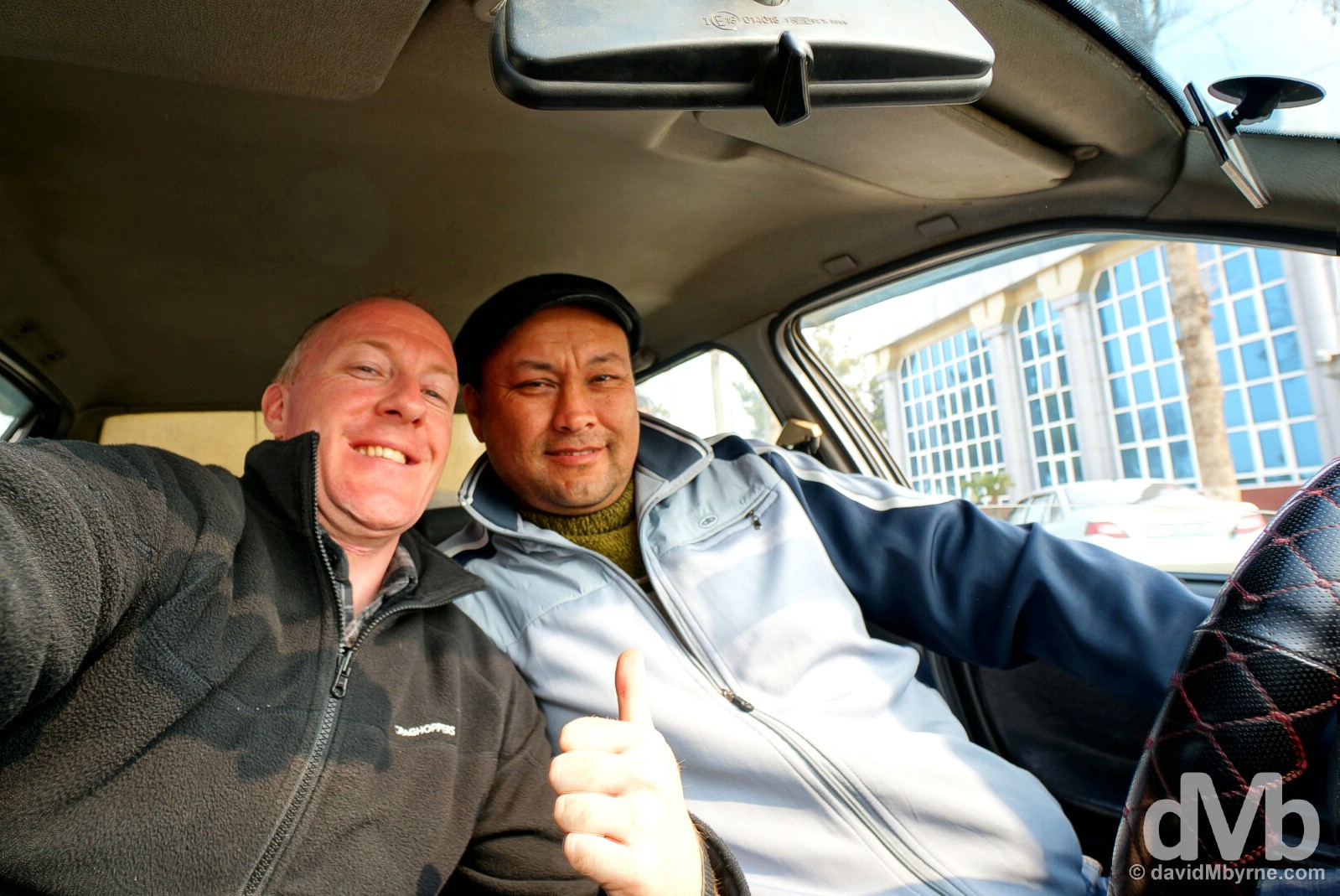
This guy, who could speak great English thanks to his mother being an English teacher, took me from the border to Andijon, sorted me out with a black market money changer, and delivered me to onward transport. He told me a lot about Uzbekistan for the 30 minutes I was with him: how he doesn’t like the strict policing of the state (we passed through more than a few checkpoints while covering the 40 kilometres from the border to Andijon); he explained the worthlessness of Uzbekistan’s currency, the som (see below); & he told me why every car on Uzbek roads is either a Chevrolet/Daewoo (because GM produces them in Uzbekistan & ‘foreign’ cars are frowned upon). He knew me as Dave from Ireland – that’s how he introduced me to the money changer & onward transport guy – but I for the life of me can’t remember his name. All I know is that he was 38, he was married with 2 kids, that he’d love to travel, & that he was a hero today. Andijon, Uzbekistan. March 4, 2015.
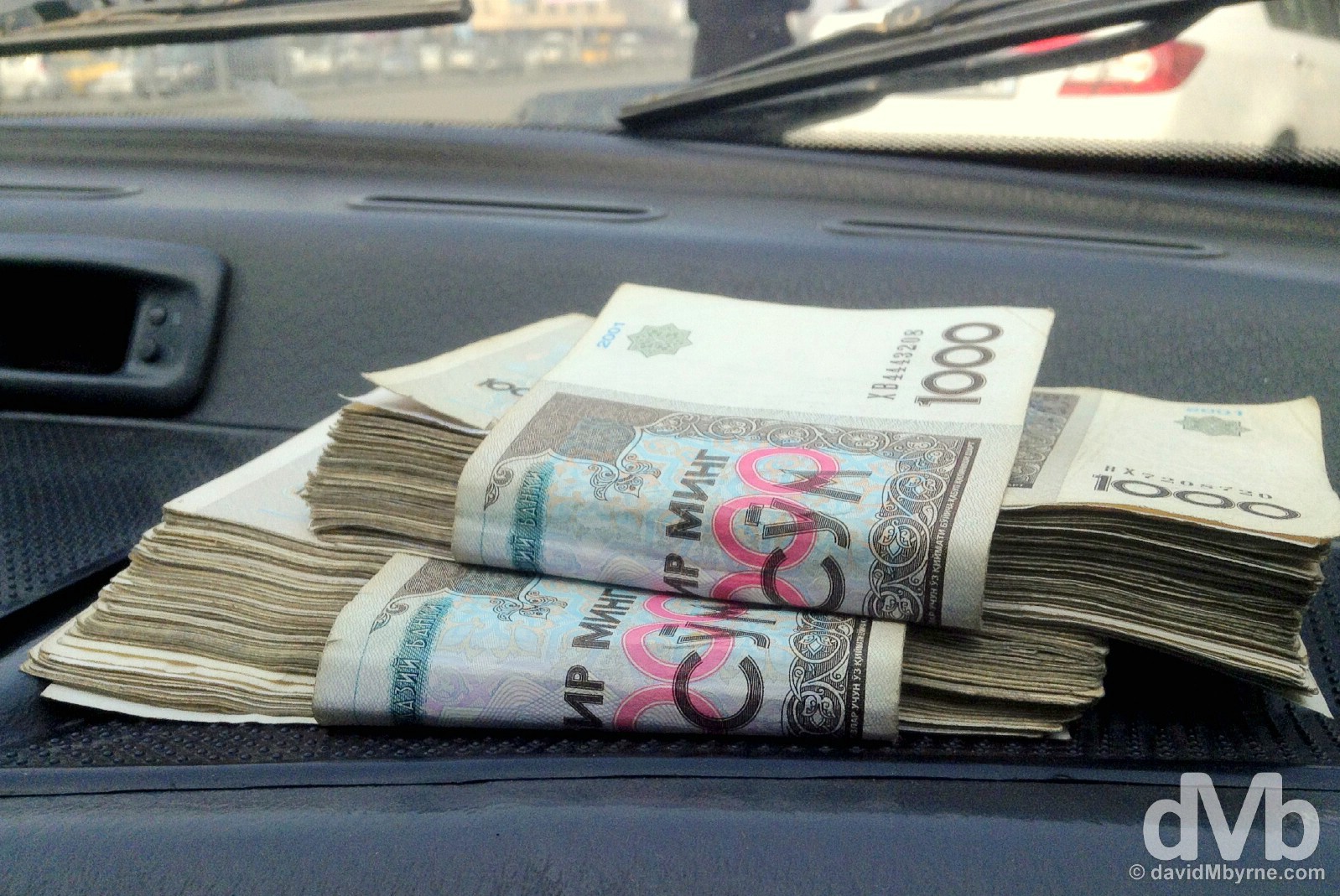
The money changing. How bizarre this was. I initially requested to change US$100 (the US$ is King & Queen over here) but when it arrived through the window & onto the dashboard in front of me (seriously) in 1,000 Uzbek som notes/bills, all 384 of them, I rethought that idea and duly downsized to $50, good for ‘only’ 192 notes/bills. It was/is still a big wad of almost worthless cash. The official exchange rate says US$1 runs to about 2,500 Uzbekistan som (UZS) but no one uses the official rate, only the black market rate which actually gets you approximately 3,800 som to the dollar. It’s a strange system but one that seems to work, the grumblings of the locals aside. The largest note, of which there doesn’t seem to be too many in circulation, is 5000 som, equivalent to €1.90, or €1.25 at black market rates. Best have large pockets when you visit Uzbekistan. Andijon, Uzbekistan. March 4, 2015.
Setting out this morning from Osh in Kyrgyzstan I had planned reaching Kokand in Uzbek’s Fergana Valley. En route I decided to push on for the capital, Tashkent, the largest city in Central Asia and my present location. As a result, today was a long day of travel but an eventful one. I’ll be here in Tashkent for a few days and will start my explorations of the city tomorrow. I gotta start eating into that wad of cash.
Date || March 7, 2015
Location || Samarkand, Uzbekistan ( )
)
With all due respect to the architecture (both of the Soviet-era kind & of the new wacky 21st century kind), the snow-capped mountain vistas, & the general Russification that I have enjoyed in Kazakhstan & Kyrgyzstan before it, Uzbekistan is why I came to Central Asia. And the Big Uzbek Three of Samarkand, Bukhara & Khiva are the reason I came to Uzbekistan.
The long-time capital of Central Asian culture & an historical overload, the country is the birthplace of Timur (1336-1405), a.k.a. Tamerlane, & there’s barely a regional dictator who didn’t try his hand at grabbing this part of Asia – everyone from Alexander The Great to Genghis Khan to Stalin has left their mark here. Uzbekistan is also the centre of the fabled Silk Road boasting the aforementioned & well-known caravan-stop towns of Samarkand & Bukhara, both full of audacious, blue-domed & tile-heavy Islamic architectural gems that combine for what might just be the greatest Islamic architectural show on earth. Yep, on earth. OK, so the levels of Central Asian dust have ratcheted up quite a bit, it’s hard to find a good coffee, internet access is woeful, & dealing with fistfuls of Uzbek som to buy so much as a shashlik (lamb kebab) or a plate of plov (ubiquitous Central Asian dish of meat-based rice & the Uzbek national dish) is a pain. But all that said, Uzbekistan is an easy & safe place to travel, the people are genuinely warm & hospitable (not to mention immensely curious), accommodation standards are high, & chances are that each and every sight is going to be a showstopper.
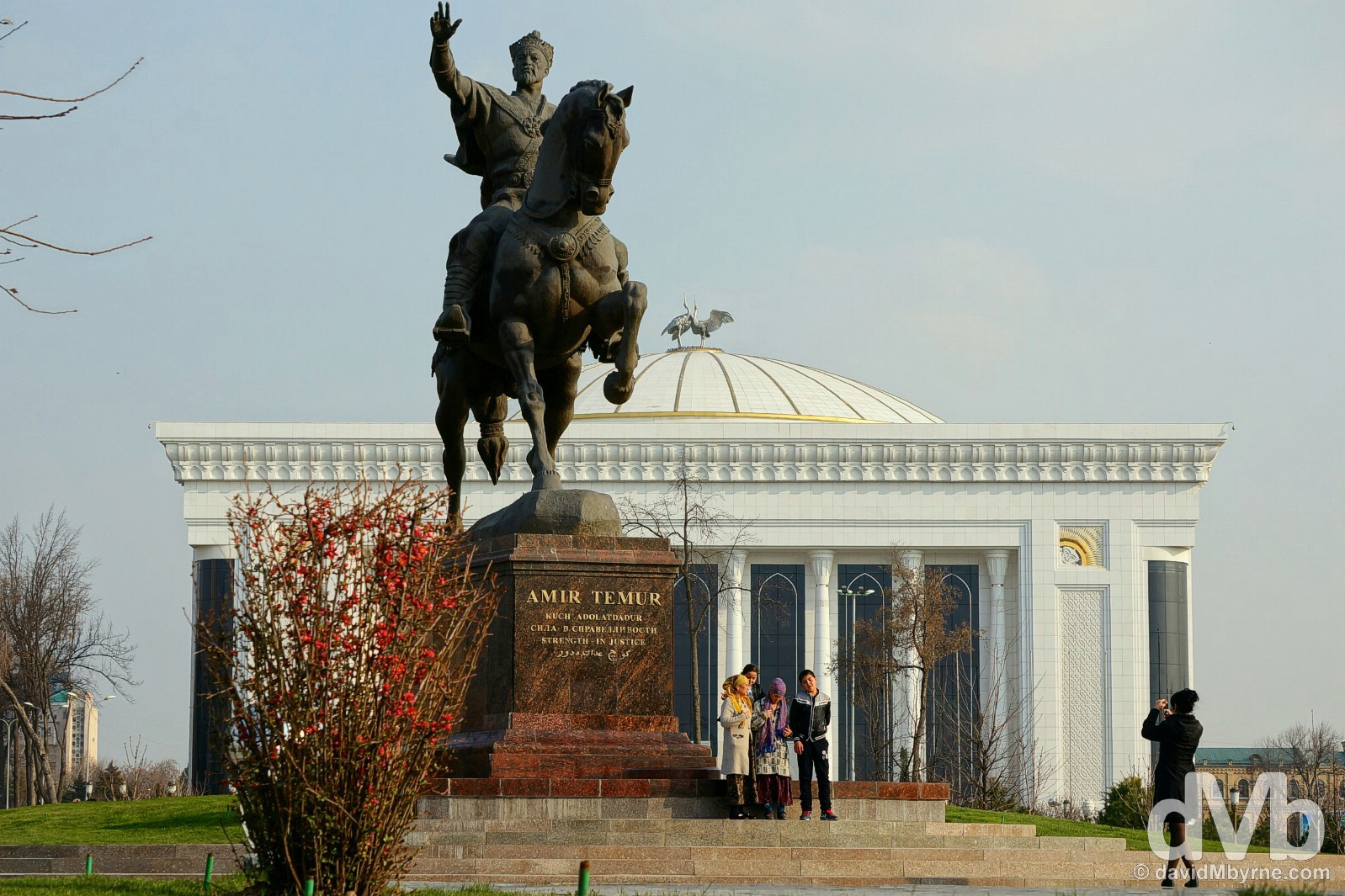
Photo time by the Timur Statue in Amir Timur Maydoni, the ceremonial centre of the Uzbek capital of Tashkent, a vast grassy space surrounded by some impressive buildings. This is where Central Asia’s biggest city really shines, especially on nice day. Timur (1336-1405) is history’s most famous/infamous Uzbek. Historians proclaim his savage rampages through the region killed some 1 million people. Lame in his right leg following a riding accident when he was 27, he is often compared to the Mongol Genghis Khan (1162-1227) – both were heads of massive dynasties & tyrants who slaughtered masses of innocent people – but it was Timur’s defeat of the declining Golden Horde in 1395 that finally signaled the end of the Mongol empire, the largest the world has ever seen. This also marked the predawn of the Russian state. The rest, as the saying goes, is history, and fascinating history at that. Tashkent, Uzbekistan. March 5, 2015.
Tashkent On Hold
I’m in Samarkand. I’ve just disembarked the train from Tashkent having spent the last 3 days & 3 nights, all my time thus far in Uzbekistan, in its sprawling capital. I kept busy in the city, Central Asia’s largest urban centre & a city that surprised me with its beauty, cleanliness & array of sights. I’d read about Tashkent beforehand and as a result wasn’t expecting much from it – few seem to speak highly of the city. But I liked it (the glorious weather & low 20C temperatures helped). Stella didn’t believe me when I told her that. She was the friendly Uzbek girl who sat beside me on the train drumming up foreigner/local conversation (her English was great). Everyone in my vicinity in the carriage was eyeing me with curiosity & suspicion, especially Stella when I told her I enjoyed my time in Tashkent; she thought I was just being polite, just saying so so as not to offend (even though she was a Bukhara girl who didn’t speak overly highly of her capital). The plan was to use the three hour and 30 minute train ride to script a Tashkent blog entry. Stella put pay to that idea as we compared Uzbek this & Ireland/Europe that, spoke of common hopes for the future, & swapped facebook details. I’ll be back in Tashkent next week (after 3 nights each in Samarkand, Bukhara & Khiva) so I’ll post more digital delights from the city then. But for now here’s one more capture from the last few days. Yes, and believe it or not Stella, it’s a big thumbs up from Tashkent.
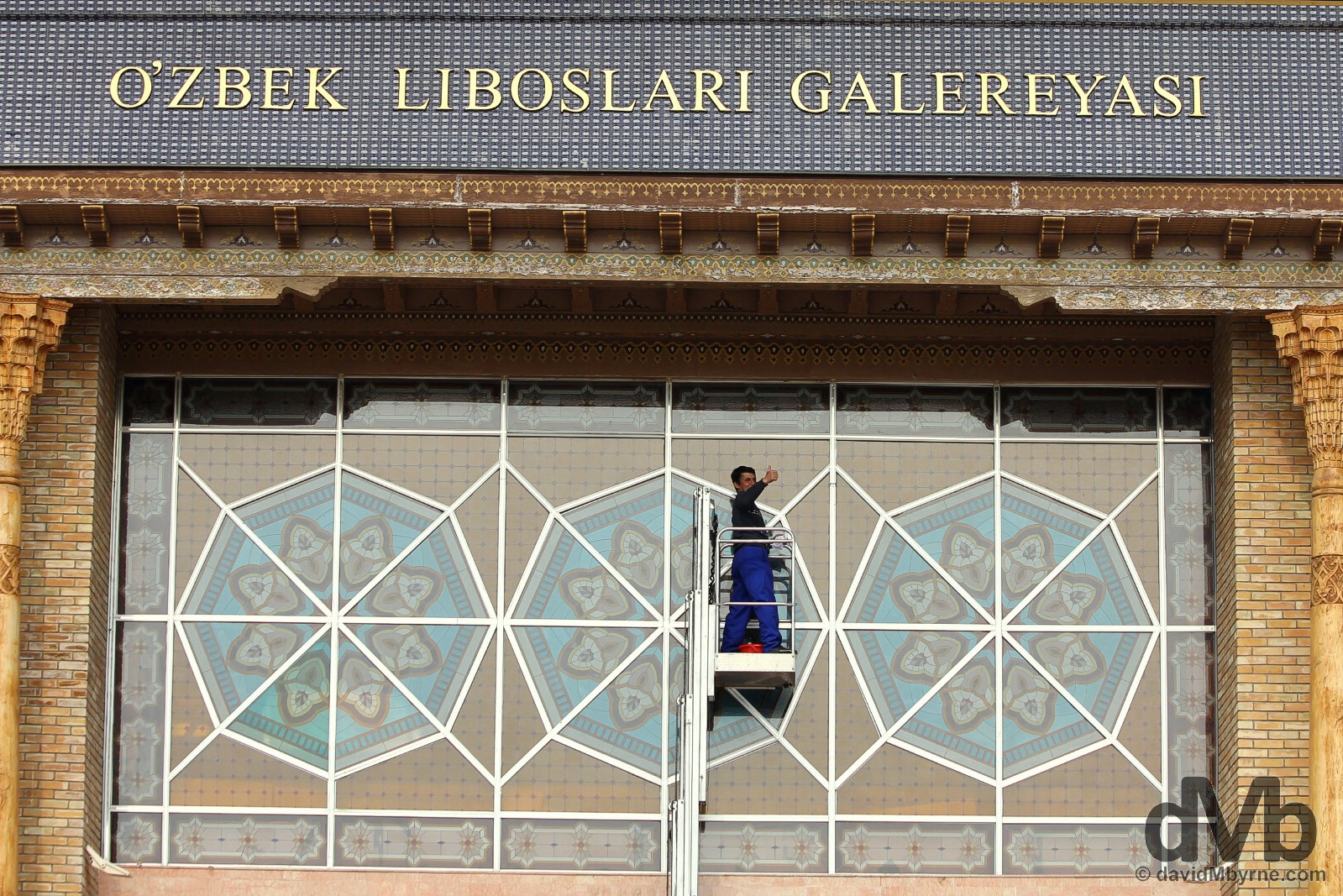
I give Tashkent the thumbs up, just like this guy gave me. He was cleaning the big windows on the even bigger facade of the city’s Centre of National Arts. I was quite some distance away but he still saw me and posed. I returned the gesture & he duly got back to work. Just another friendly Uzbek in the country’s capital. Tashkent, Uzbekistan. March 6, 2015.
THE BIG THREE - #1 - Samarkand
Date || March 10, 2015
Location || Samarkand, Uzbekistan ( )
)
I’ve just spent three days & nights in Samarkand, Timur’s 14th century capital, the historic & ancient Uzbek city awash with epic, spellbinding Islamic architecture. Each of the three days were very different: day one was wet & dank; day 2 gloriously sunny & warm; & day 3 overcast and cold with a treat of snow that never quite came. But everyday was special.
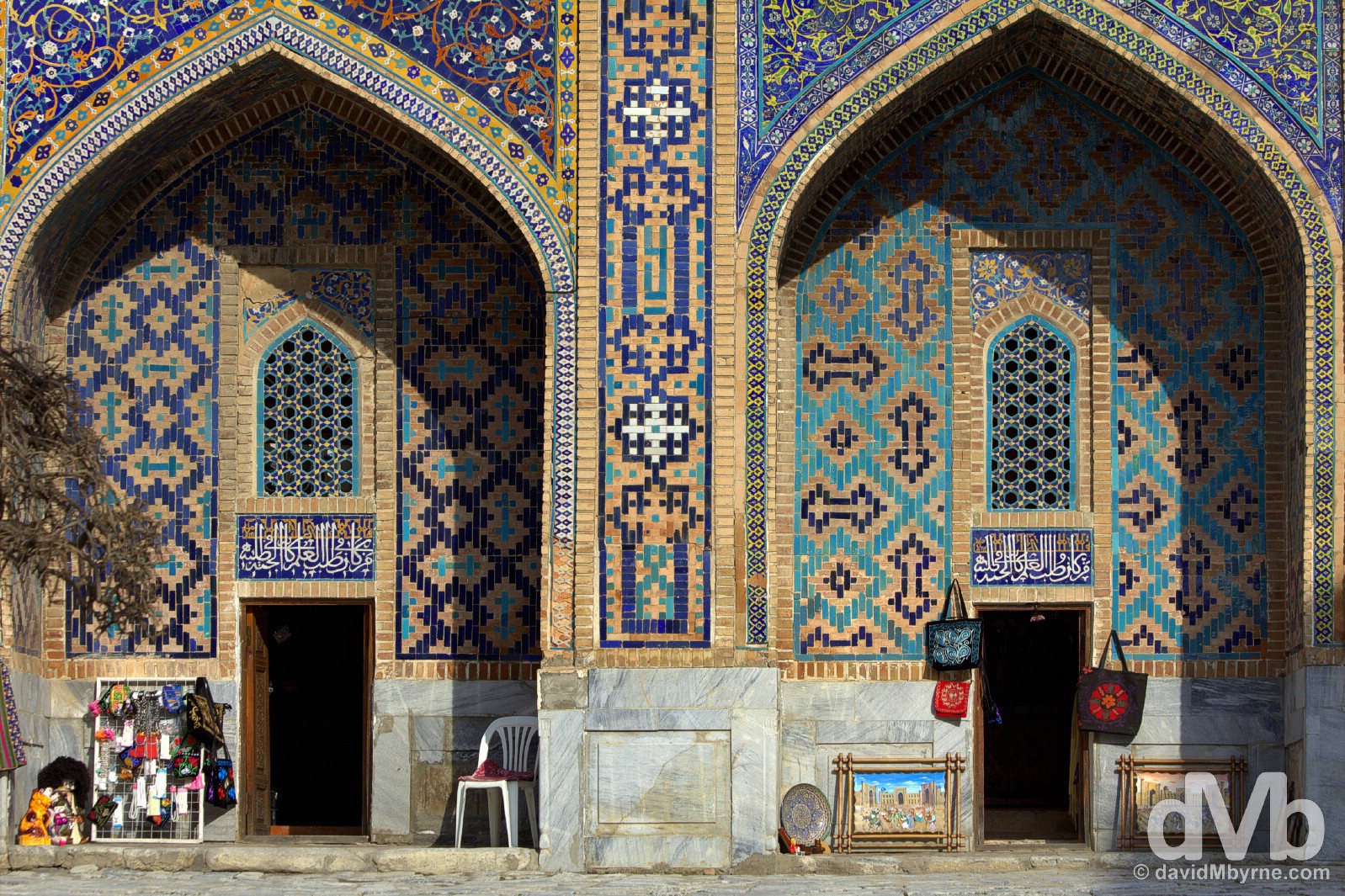
Souvenirs for sale in the courtyard of the Tilla-Kari Medressa of The Registan in Samarkand, Uzbekistan. March 8, 2015.
Samarkand
Samarkand, in the heart of the ancient Silk Road & deeply infused with its fascinating history, gets top billing on many a Central Asia itinerary. The city, a UNESCO World Heritage site since 2001, boasts some of the Islamic world’s most spectacular, surreal, & audacious architecture all rolled into one. Hyperbole aside, it really is an amazing place & I’ve spent my time here trying to adequately photograph the distinctive turquoise-blue domes & mind-boggling tilework of the city’s fabled larger-than-life monuments. Here’s some of what I captured accompanied, as usual, with my verbose insights. Destination photography & insights people, destination photography & insights.
– UNESCO commenting on ‘Samarkand – Crossroad of Cultures’
The Registan
Uzbekistan’s most famous & iconic sight, some say the three tilting medressas (Islamic schools) that comprise the Registan – Ulugbek Medressa (left, 1417-1420), Tilla-Kari Medressa (centre, 1646-1660), & Sher Dor Medressa (right, 1619-1636) – combine to produce what is probably the best single attraction in the whole of the Central Asian region.
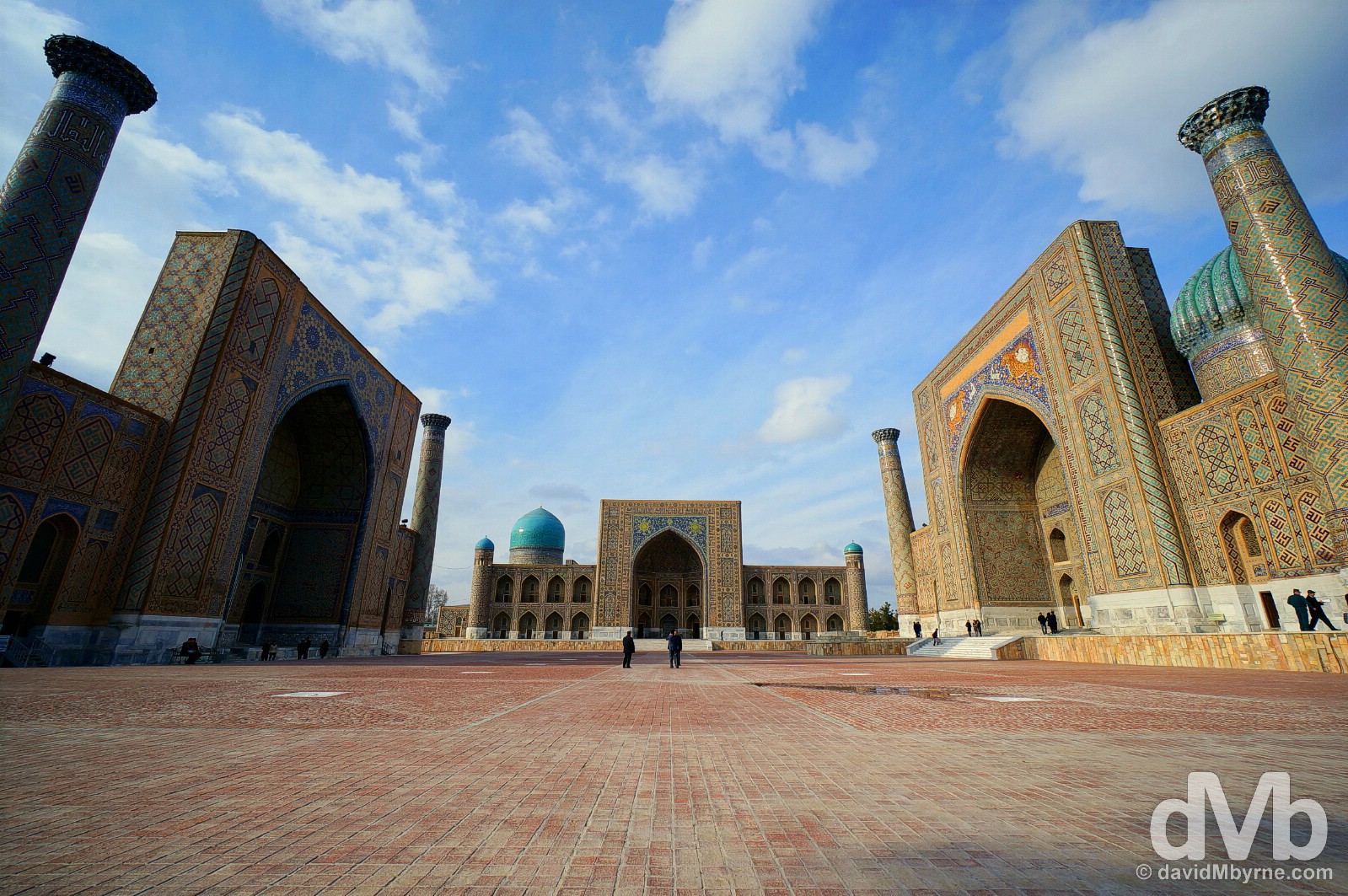
The Registan. One of the world’s most icon sights, I’d been longing to lay eyes on The Registan for as long as I’d been planning a Central Asian adventure. Seen here is the large plaza facing The Registan’s mammoth, tile-infused edifices. Among the world’s oldest preserved medressas, the three structures seen here have taken a beating over the years & their appearance today is largely the result of many restorations, particularly in the 20th century. Once medieval Samarkand’s commercial centre, today one of the Islamic world’s greatest architectural ensembles survives solely for tourists – the open-air interior courtyards of all 3 medressas, while housing an overload of astonishing tilework & mosaics, also house the usual tacky tourist tat shops you’d expect to find at such a popular tourist attraction. Samarkand, Uzbekistan. March 8, 2015.
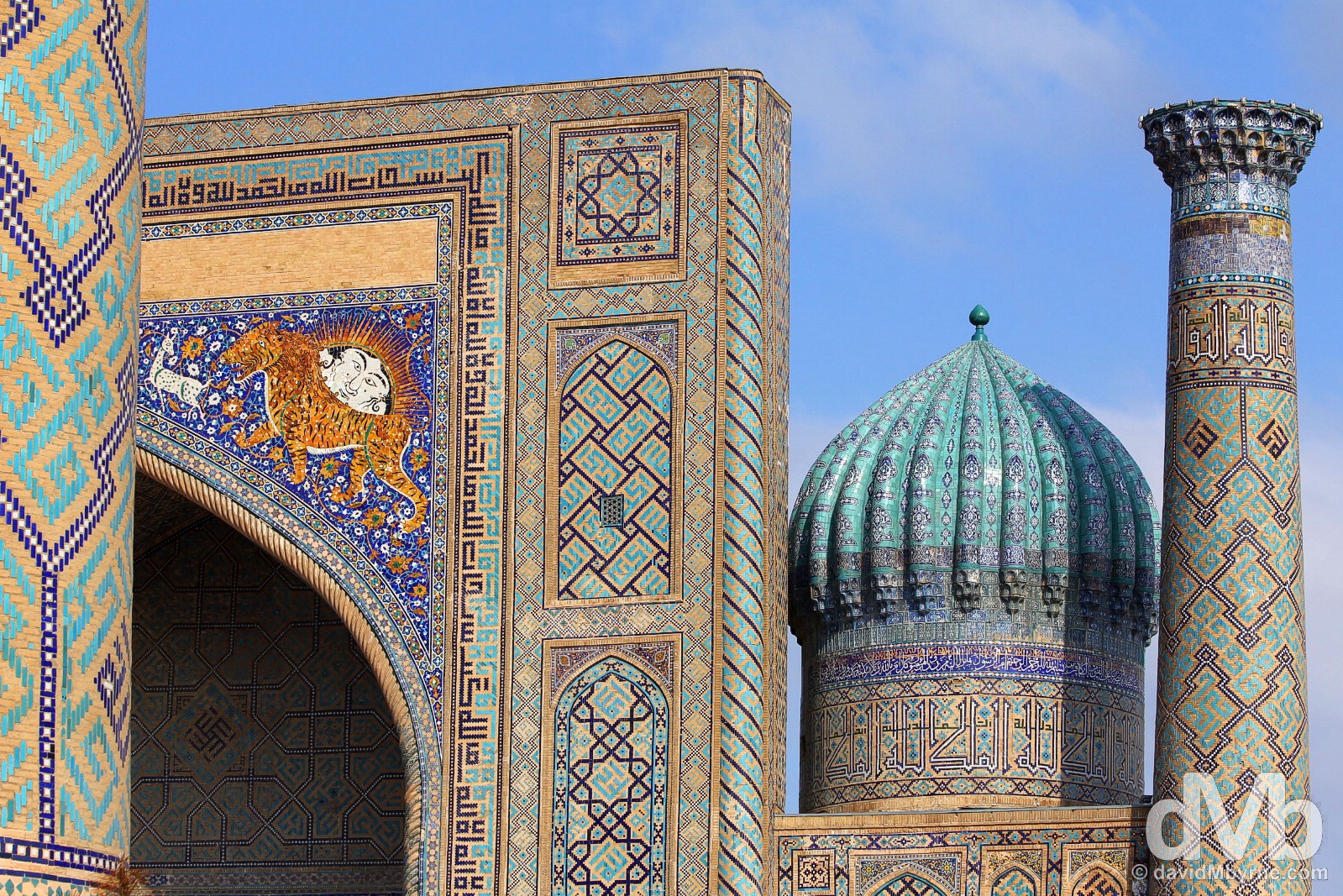
As if all that dazzling tilework wasn’t dazzling enough, a very distinctive feature of the tilework adorning the facade of the Sher Dor (Lion) Medressa is the sight of two lions, one on either side of the medressa’s massive arched portal (although they, ahem, look more like tigers to me). Lions or tigers, the decoration goes against the Islamic prohibitions on the depiction of live animals. The Registan, Samarkand, Uzbekistan. March 8, 2015.
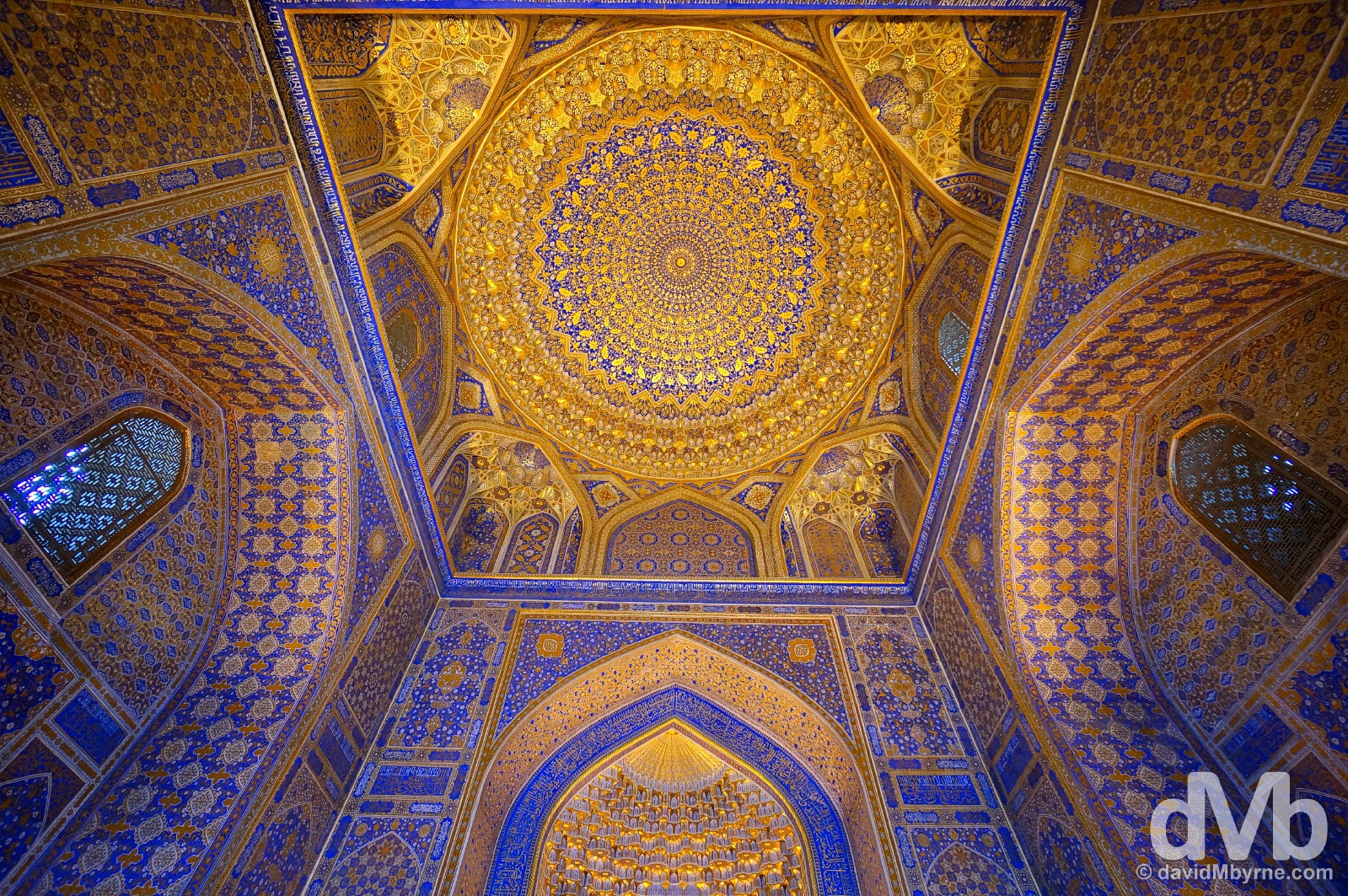
This was possibly the highlight of The Registan ensemble for me, the ceiling of the main mosque inside the Tilla-Kari Medressa which, incidentally, was my favourite of the three medressas. Heavy with gold leaf to symbolise Samarkand’s wealth at the time of the mosque’s construction (it was completed in 1660), it really is quite the sight, one I wasn’t supposed to photograph but couldn’t resist not doing so. Tut tut. Tilla-Kari Medressa of The Registan in Samarkand, Uzbekistan. March 8, 2015.
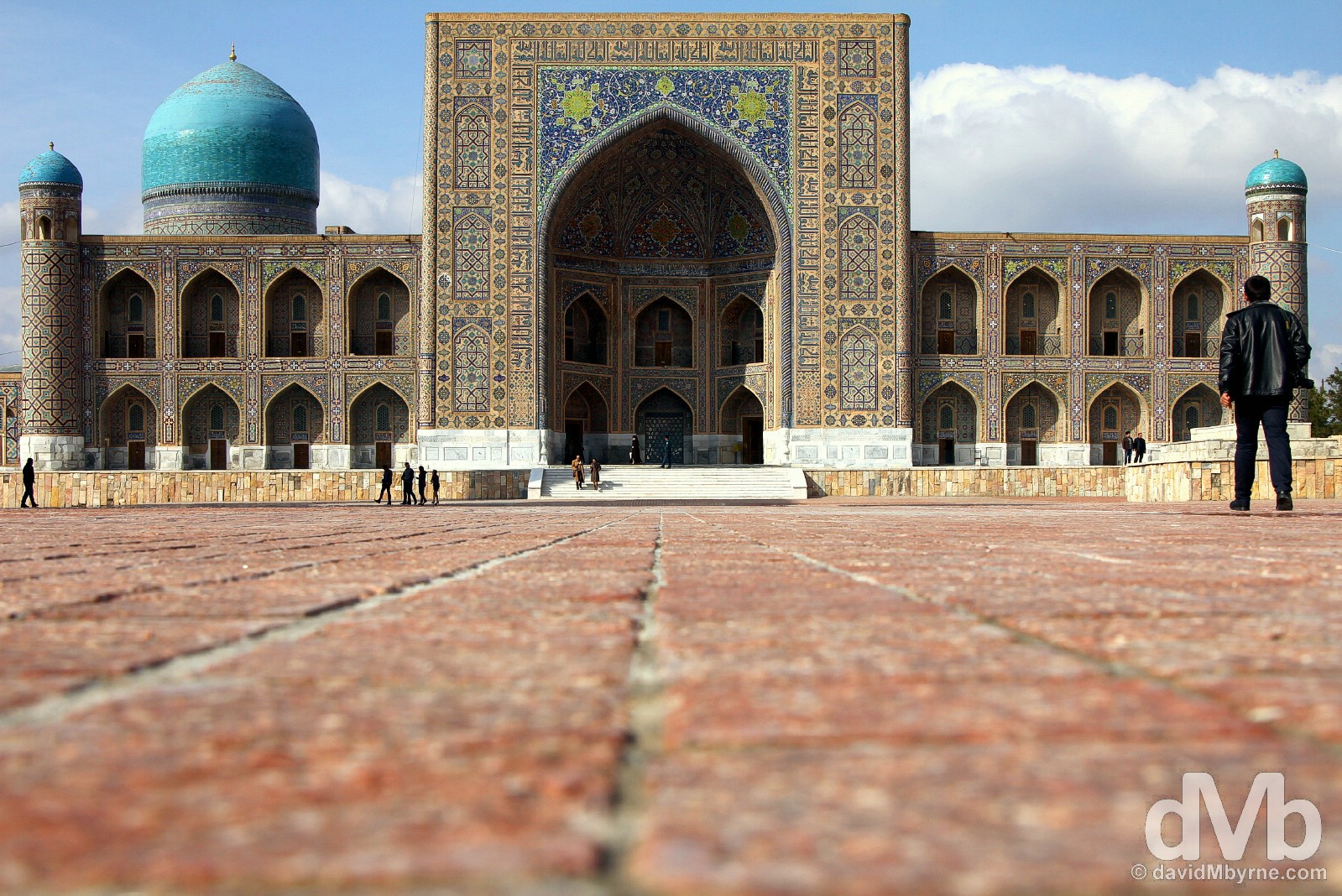
The 355-year-old Tilla-Kari Medressa, the baby of the trio of medressas of The Registan in Samarkand, Uzbekistan. March 8, 2015.
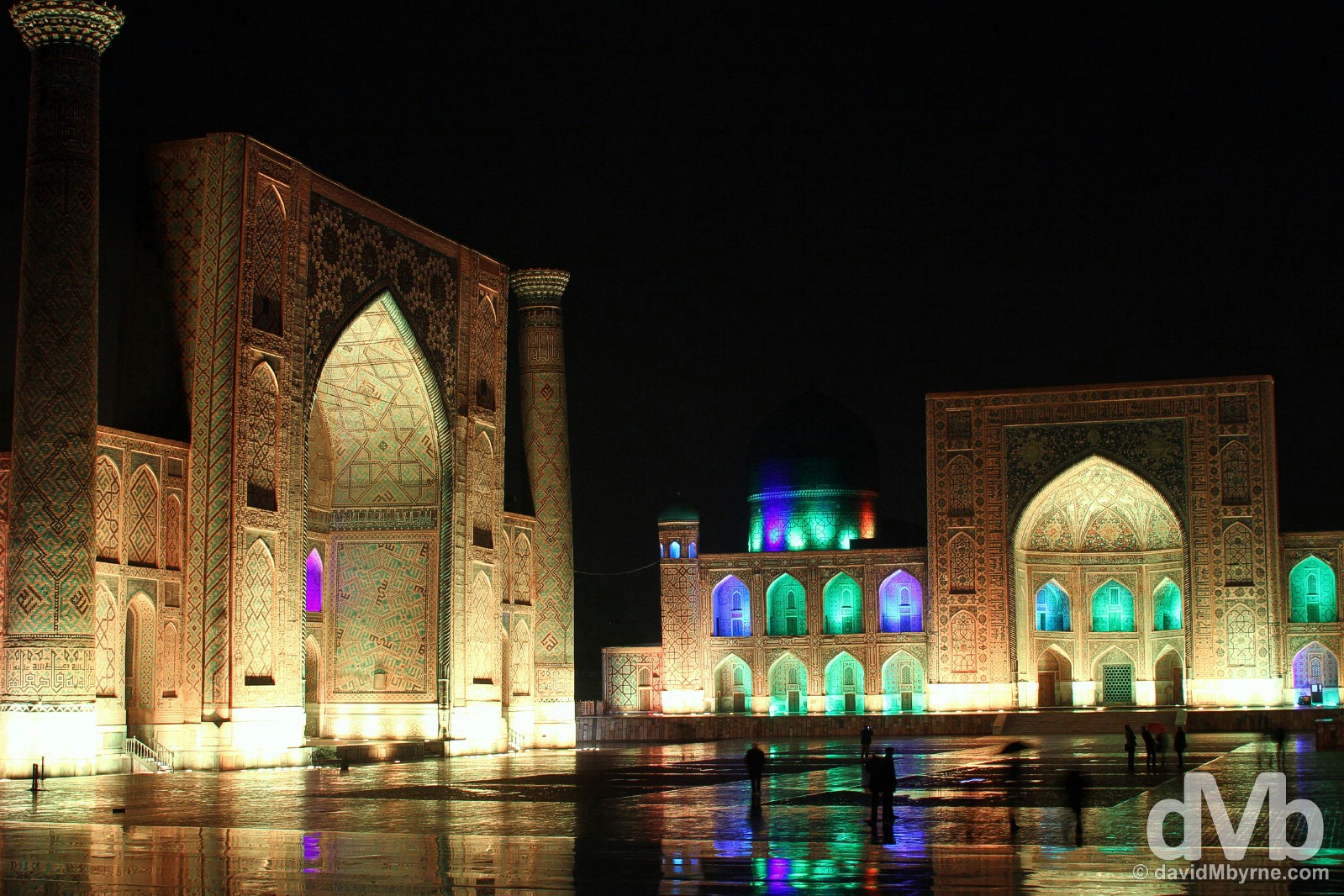
I’ve seen a lot of The Registan over the last few days. I’ve seen it at various times of the day and in various weather conditions. My very first glimpse on day 1 – shortly after stepping out of a taxi from the train station & weighed down with bags & in heavy, unexpected snow – was memorable; first glimpses always are. Terrible photography conditions but memorable nonetheless. Later that night it had stopped snowing (but was raining heavily) & I was treated to a Registan Sound & Light Show, a non too regular occurrence this time of year when not too many tourists are around. Sound & Light Show in the rain at The Registan in Samarkand, Uzbekistan. March 7, 2015.
Today, my departure day from Samarkand, & I woke to about a foot of snow. I hadn’t planned another visit to The Registan, but I hadn’t planned on it snowing either. So I did mosey on over seen as it was snowing and my B&B was just around the corner.
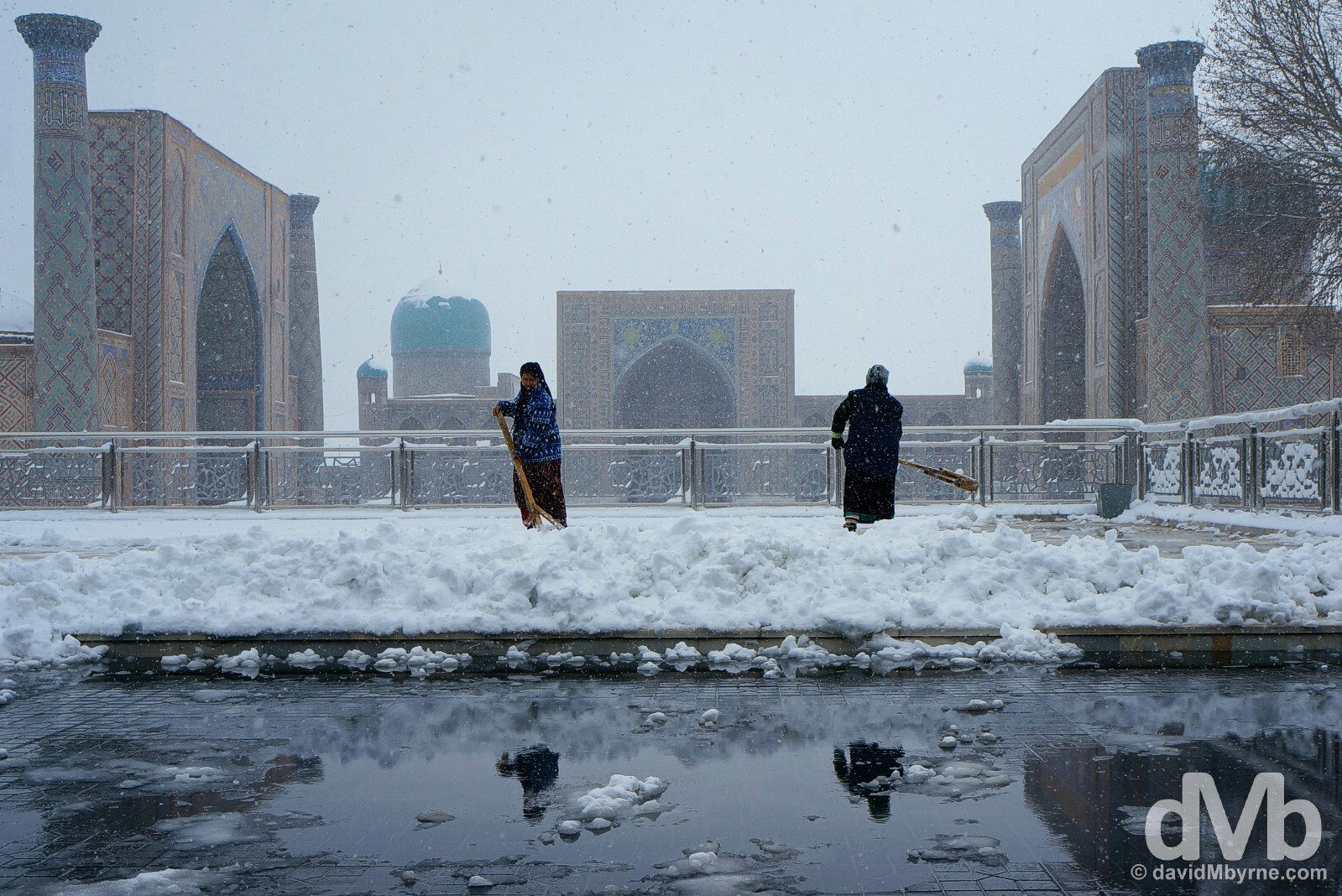
Clearing snow from the viewing platform overlooking The Registan in Samarkand, Uzbekistan. March 10, 2015.
Right, enough from The Registan. There’s plenty more to dazzle you in Samarkand.
– ‘The Golden Journey to Samarkand’ by James Elroy Flecker, 1913
Bibi-Khanym Mosque
Day 2 sightseeing in Samarkand started by poking around the biggest & most famous of Samarkand’s many, many mosques, the massive Bibi-Khanym. It was overcast but as soon as I walked into the structure’s central courtyard the clouds parted and glorious sunlight illuminated the tilework on the mosque’s towering façade. The sun stayed out for the rest of the day, seemingly following me as I went.
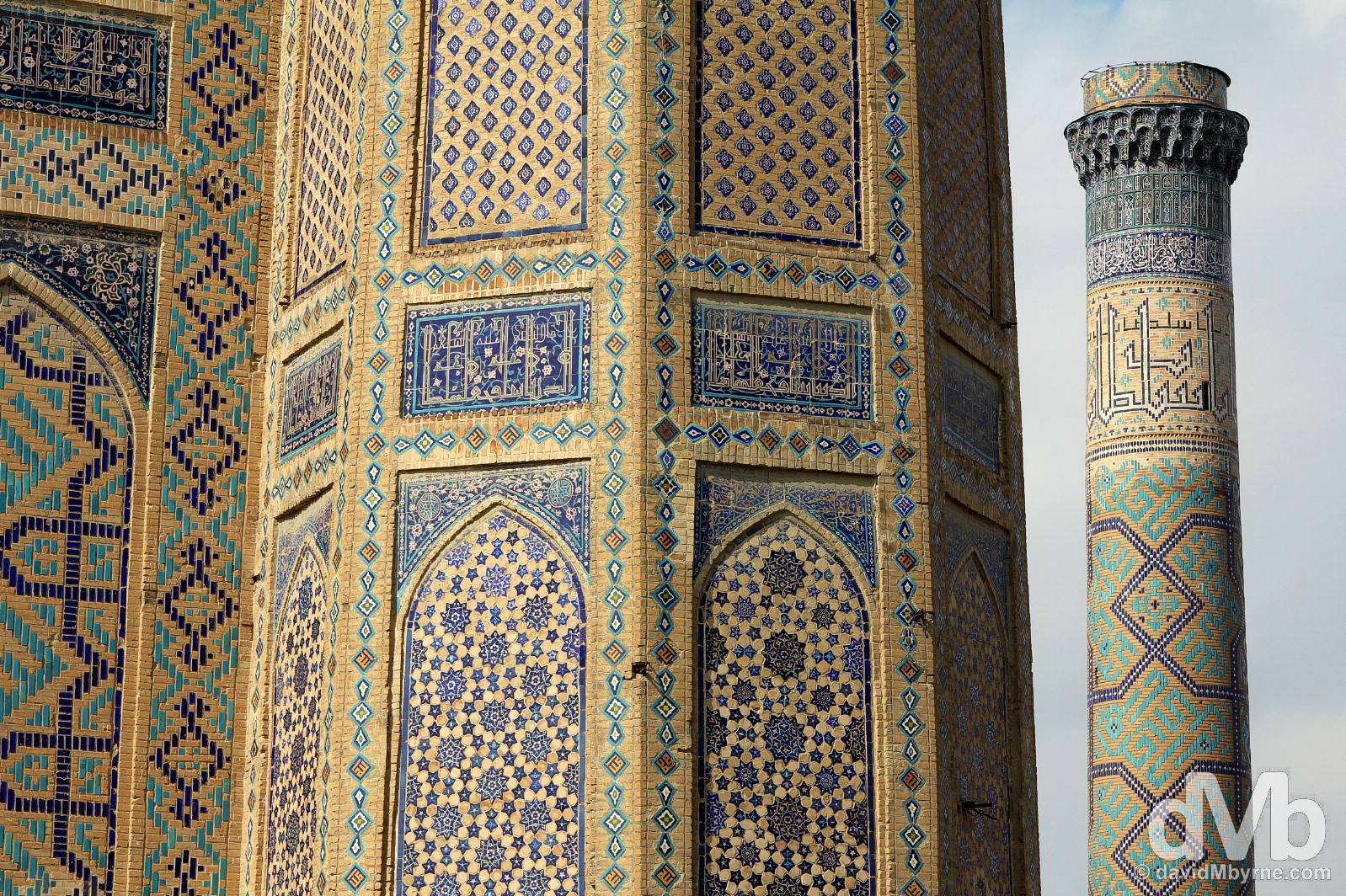
Tilework detail on a section of the main facade & a minaret of the Bibi-Khanym Mosque. Depending on which version of history you subscribe to, the mosque was was built for, or at the behest of, Timur’s wife, Bibi-Khanym, in the late 14th century, at which time it would have been one of the world’s largest mosques. While it till looks great in parts, it generally hasn’t aged well & last saw some major touch-up work as far back as the 1970s. Today it’s looking well past its best and could do with another serious restoration, which is the reason I loved it – peering up at the 41-metre high turquoise cupola of the main mosque while feeling the whole thing was going to collapse around me at any minute was a strangely awesome feeling. Samarkand, Uzbekistan. March 8, 2015.
Shah-i-Zinda
It was still gloriously sunny when I got to Shan-i-Zinda, Samarkand’s Avenue of Mausoleums. Located in the corner of Samarkand’s main cemetery, this is 200- 300-metre long narrow avenue of towering, mausoleums is yet another (predominately blue) tilework overload.
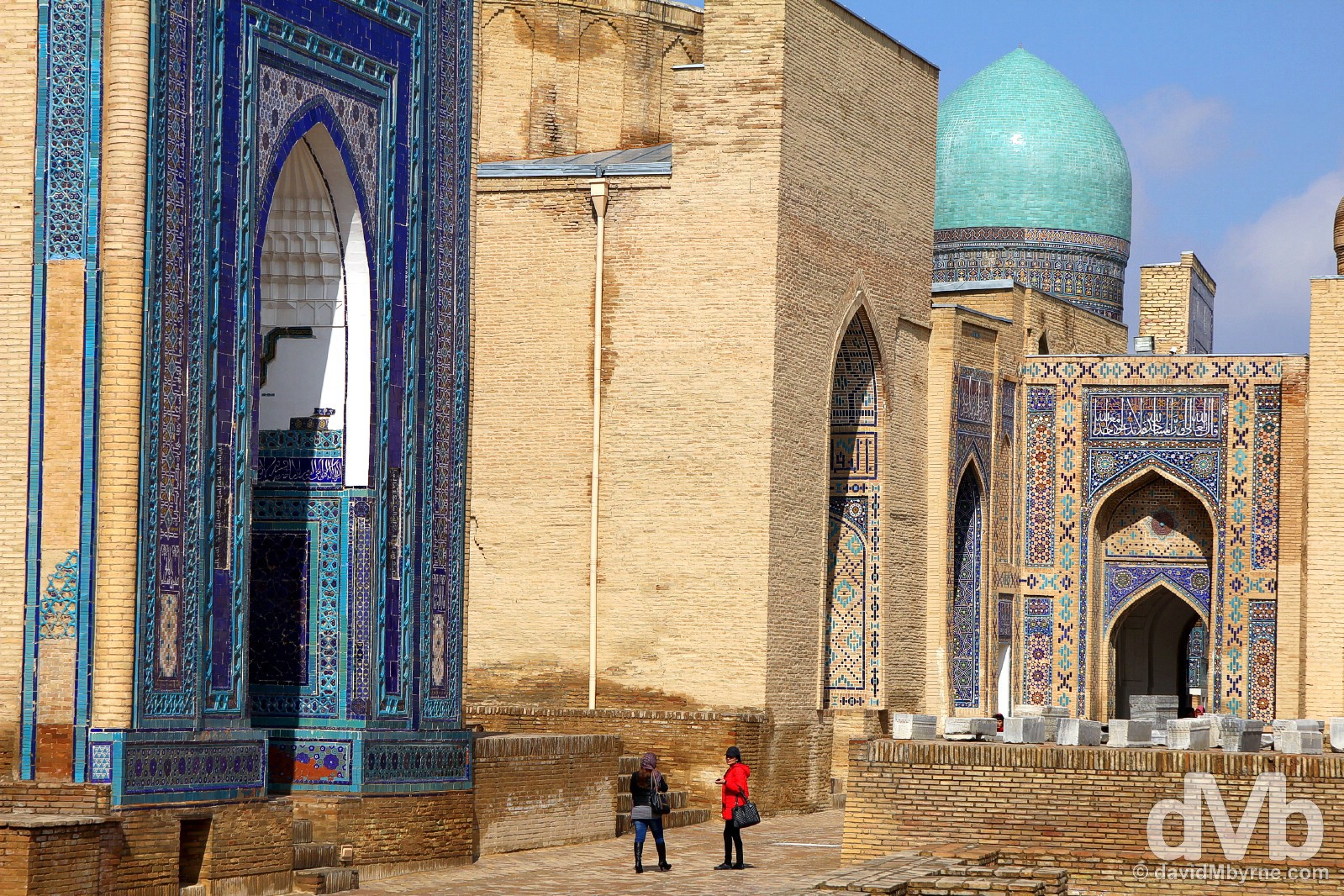
Legend says Qusam ibn-Abbas, a cousin of the Prophet Mohammed who brought Islam to the region, is entombed here in Shah-i-Zinda. Whether he is or not, what we do know for sure is that Timur & his descendants buried some of their nearest & dearest here. These include Timur’s sister, Shodi Mulk Oko, whose tomb, dating to 1372, is the highlight of the avenue boasting as it does some of the most exquisite tilework in the Muslim world. Shah-i-Zinda, the Avenue of Mausoleums, in Samarkand, Uzbekistan. March 8, 2015.
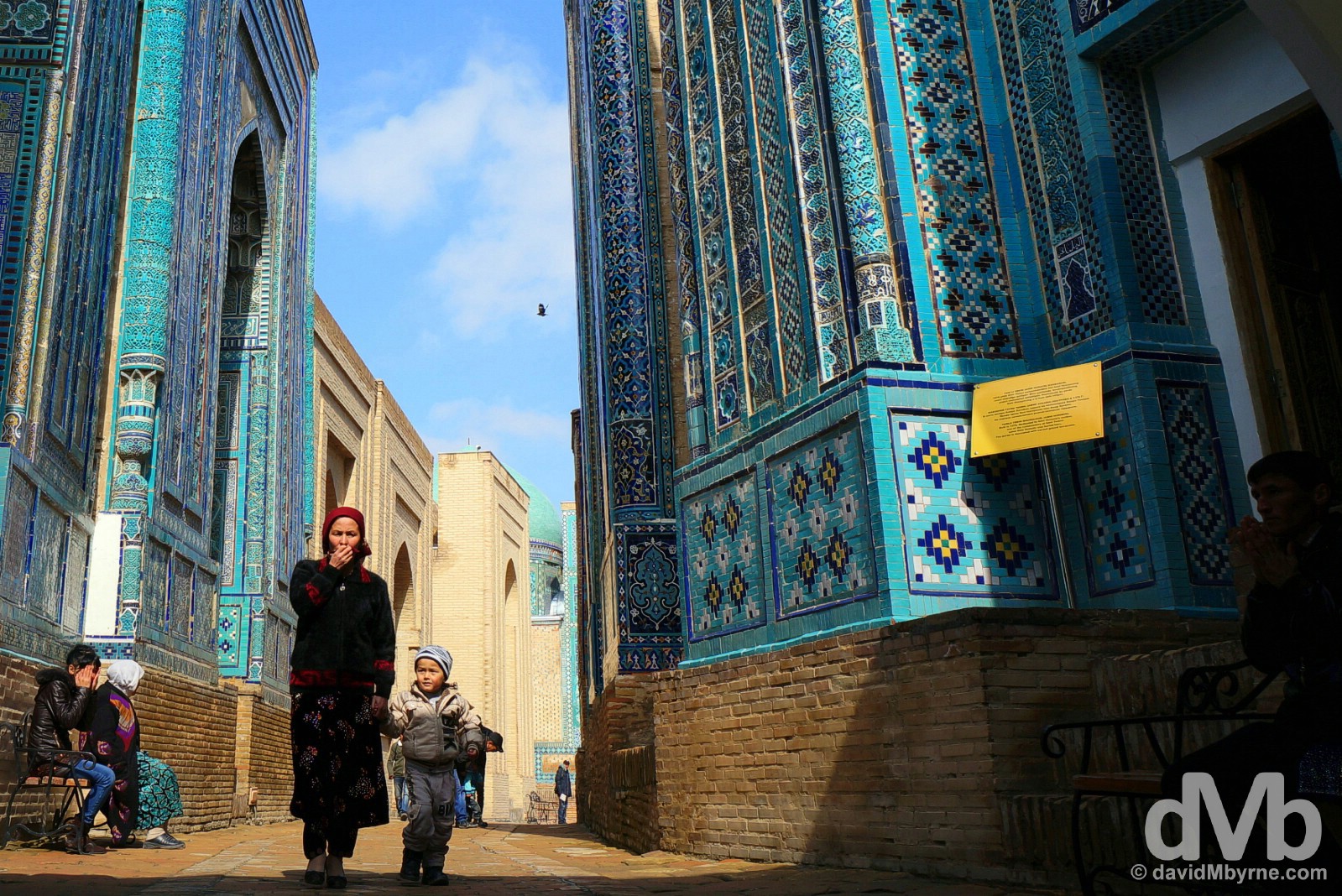
Walking through Shah-i-Zinda, the Avenue of Mausoleums, in Samarkand, Uzbekistan. March 8, 2015.
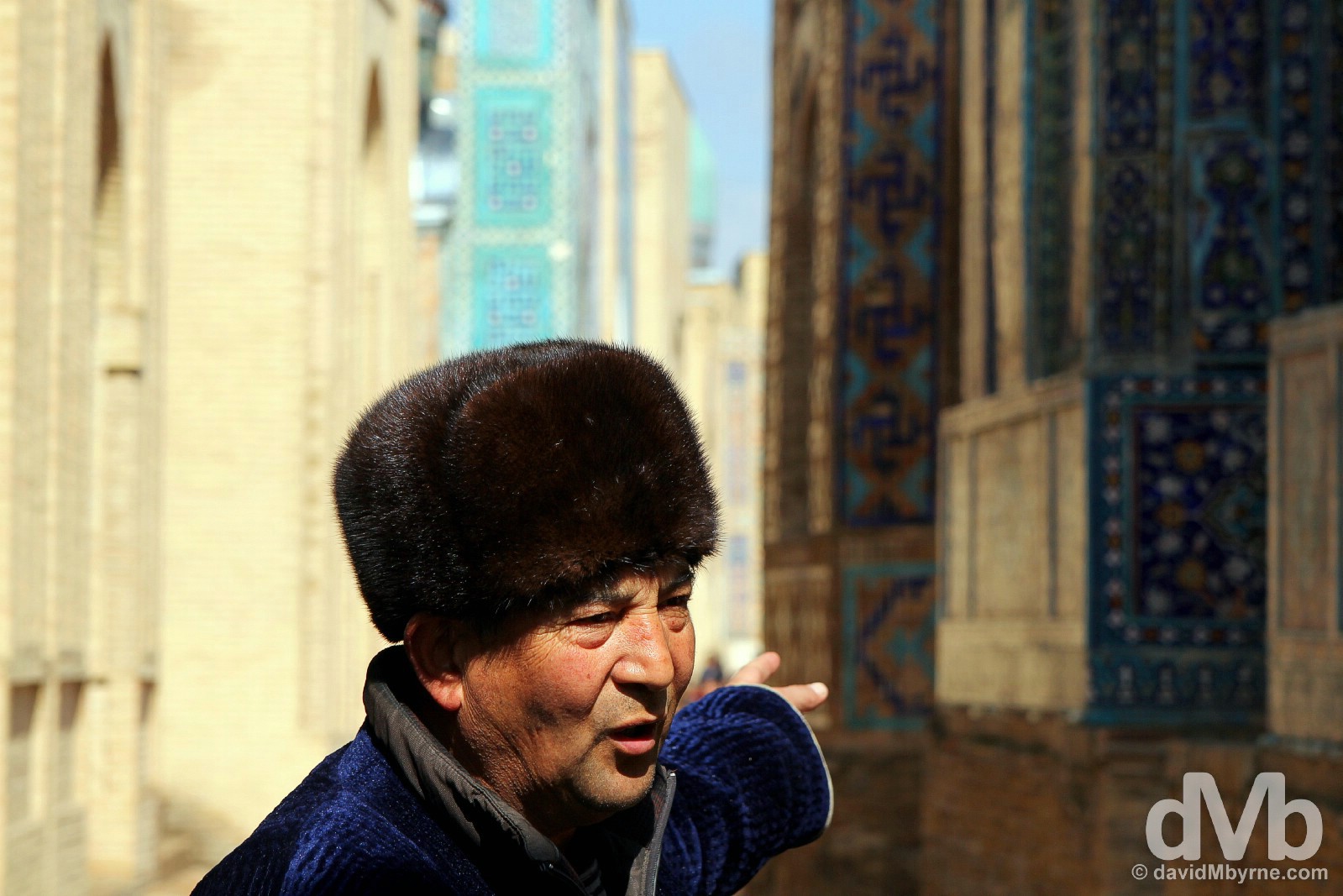
Pointing out detail at Shah-i-Zinda, the Avenue of Mausoleums, in Samarkand, Uzbekistan. March 8, 2015.
New Samarkand
Samarkand seems to know the value of the tourist dollar, and the powers that be seem intent on ‘beautifying’ the experience for tourists visiting the centuries old, tile-infused monuments of the city’s glorious past.
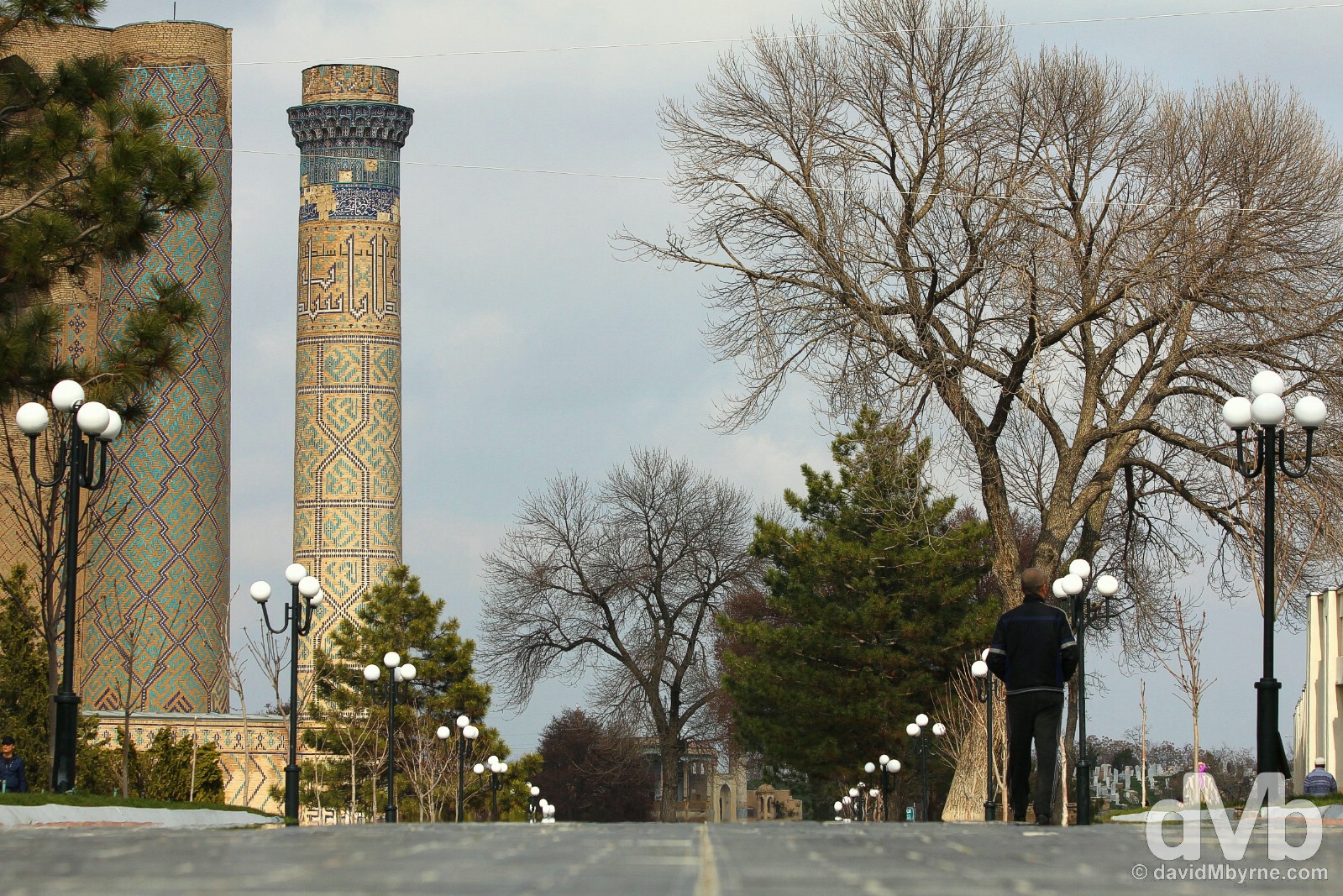
This is Toshkent, a new pedestrian street connecting The Registan to the Bibi-Khanym Mosque, a crumbling minaret of which can be seen, & the neighboring Siob Bazaar, the city’s main market. Where once there were bustling old town streets now there’s this. While it’s undoubtedly easier on the eye it’s also very uninspired, not to mention a classic contradiction – a new, sterile pedestrian thoroughfare connecting ancient, fascinating monuments. Toshkent in the ‘new’ Samarkand, Uzbekistan. March 8, 2015.
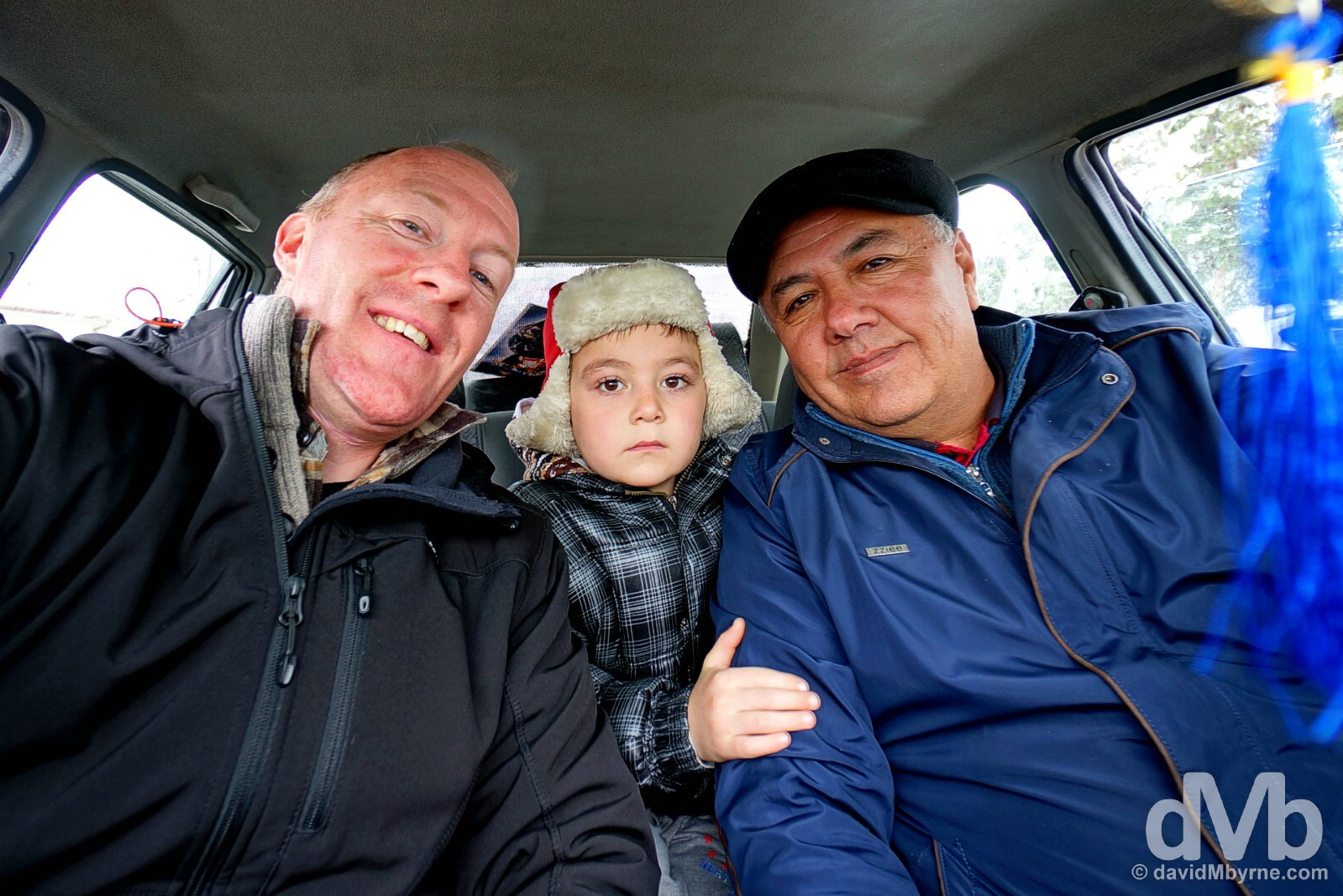
I’m continuing to feel the love from the astonishingly hospitable Uzbeks. The latest taxi journey to the train station today in Samarkand came with a wealth of advice from taxi driver Gabriel (that’s his son, Ishmil, centre) even though we didn’t have a word of each others mother tongue (OK, maybe just commonly understood words). I’ve always been good at holding ‘conversations’ without common language (it’s one of the reason I’m an adept traveller I guess) & here in Uzbekistan in particular I’ve been reminded how overrated it – common language – is (a simple smile is a much more useful tool). Gabriel requested a fare of 4,000 som (€1) for the 10-minute taxi ride. When I gave him 8,000 som he embraced me. It was a genuine, touching moment. In the taxi en route to the train station in Samarkand, Uzbekistan. March 10, 2015.
THE BIG THREE - #2 - Bukhara
Date || March 13, 2015
Location || Bukhara, Uzbekistan ( )
)
Bukhara, historical Uzbek Silk Road outpost number 2 after Samarkand, hasn’t changed much in centuries & seemingly it’s the best place in the country to get a sampling pre-Russian Uzbekistan. In fairness to the Russians, & ignoring the fact that they bombed the city in finally taking control of it in 1920, they left it as they found it meaning today the so-called ‘city of museums’ is a UNESCO World Heritage listed site contains more than 140-odd protected historical architectural monuments stretching back to the Middle Ages, everything from medressas to mosques to minarets. There’s even a royal fortress. Take that, Samarkand.
– UNESCO commenting on the Historic Centre of Bukhara
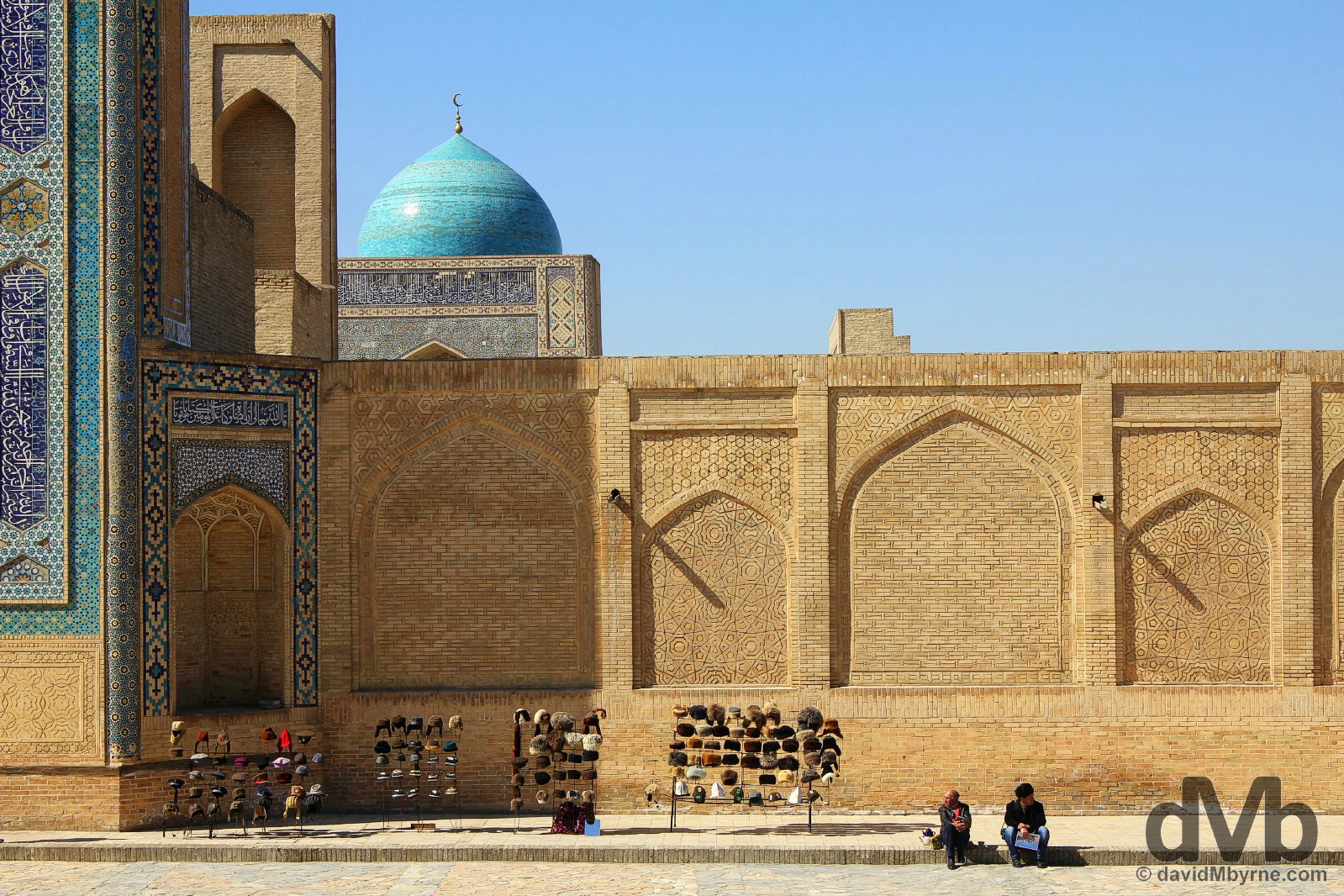
Sitting by the walls of the Kalon Mosque as seen from the steps of the Mir-i-Arab Medressa in Bukhara, Uzbekistan. March 12, 2015.
After running the gamut of weather conditions for 3 days in Samarkand before it, in Bukhara things were a little less complicated meteorologically. For the last three days I’ve been treated to crystal clear blue skies and belting sunshine, meaning at either end of the 3 hour Samarkand-Bukhara train journey I went from wrapping up against the snow to shielding against the sun. The weather here has been bizarre.
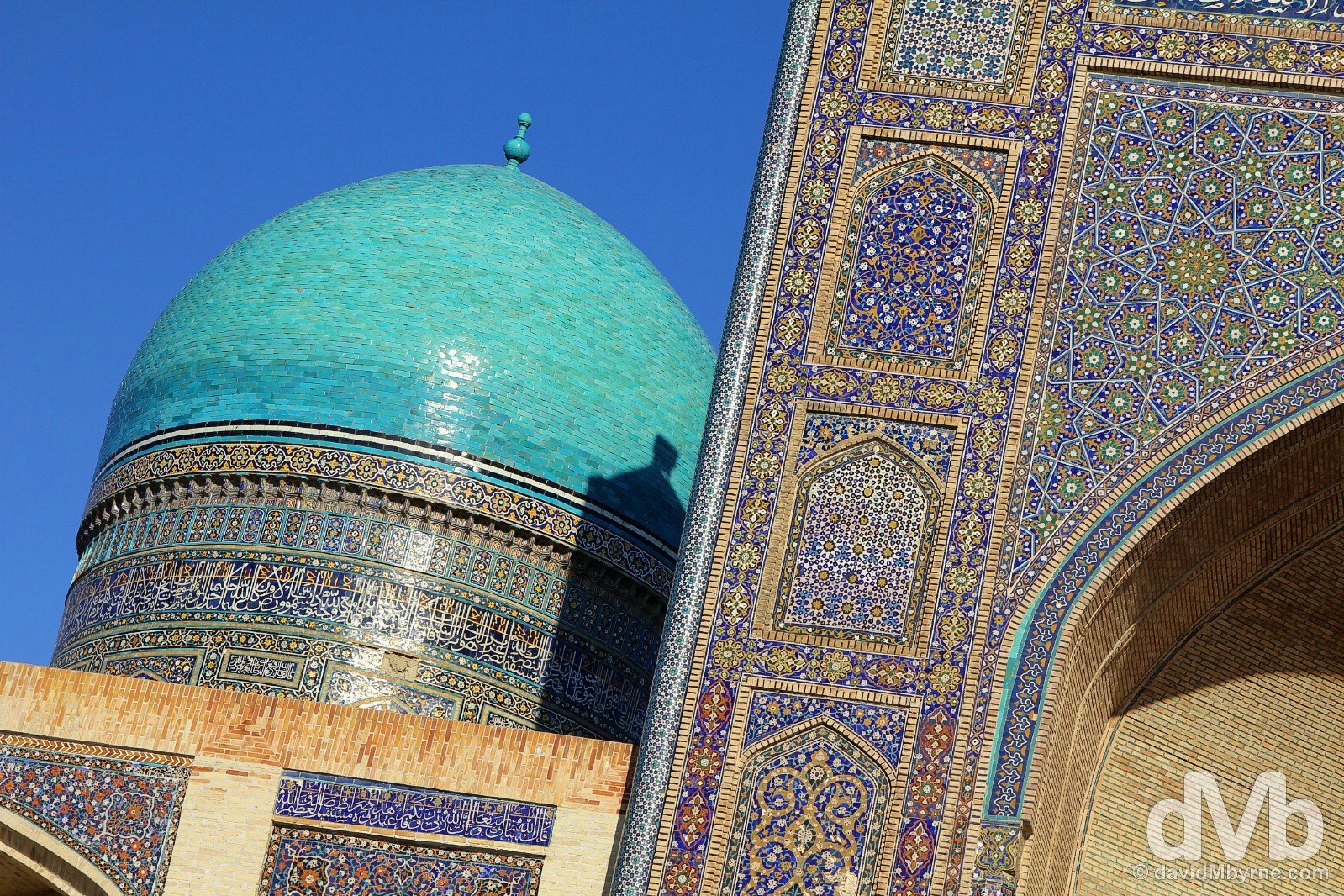
Mir-i-Arab Medressa, Bukhara, Uzbekistan. March 11, 2015.
Sizing Up Bukhara
I’ve spent my time here walking around the centre of Bukhara’s UNESCO-listed old town & poking around the inside & outside of its buildings, all the while soaking up the atmosphere, fighting the dust, & sizing up shots – the old town is small so I was able to scout & revisit locations more than once in a bid to do the city justice photographically.
Kalon Minaret
Built in 1127, the 888-year-old city landmark Kalon Minaret was probably the only Bukhara structure to escape Genghis Khan’s wrath when he razed the city in 1220 – legend says he was so taken by it that he ordered it spared. Good call.
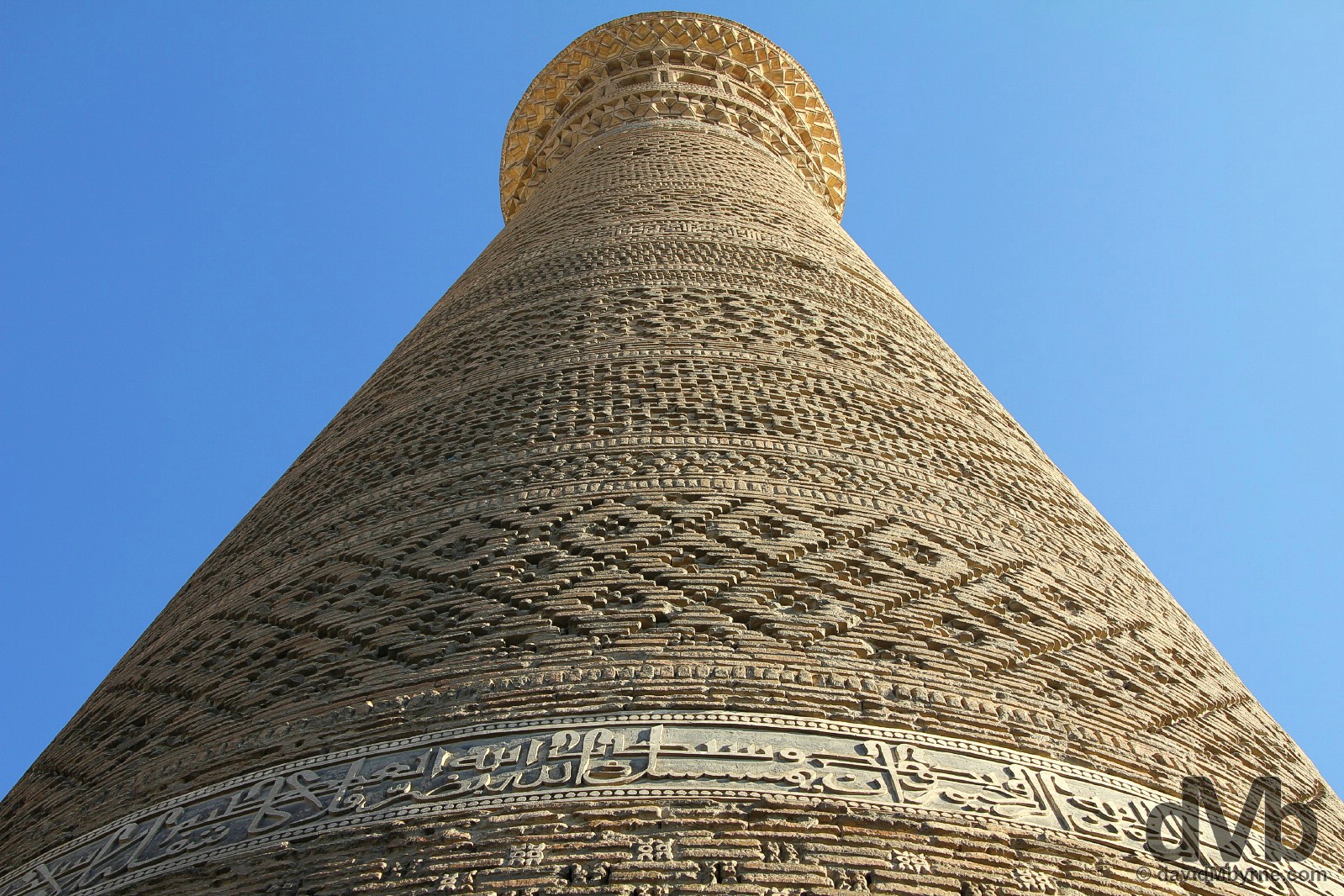
Wow. The Kalon Minaret was the first Bukhara landmark I searched out after arriving in the city & I stood at its base for quite a while watching the shadows of the setting sun slowly creep along its ornamental surface (this particular picture was captured late afternoon on day 2). The impressive structure measures 47 metres high and has 14 bands, all different, one of which, near the top, was the first use of the blue glazed tiles that were to become such a defining feature of Central Asian architecture, especially the Timurid structures of the 14th to 15th centuries. Kalon Minaret in Bukhara, Uzbekistan. March 11, 2015.
Face-To-Face || Kalon Mosque & Mir-i-Arab Medressa
The Kalon minaret is found in a sort of mini version of the Samarkand Registan, a brown space across which stand the two facing facades of Bukhara’s Kalon Mosque & the Mir-i-Arab Medressa. The interior of the former & the exterior of the latter are highlights of the old city.
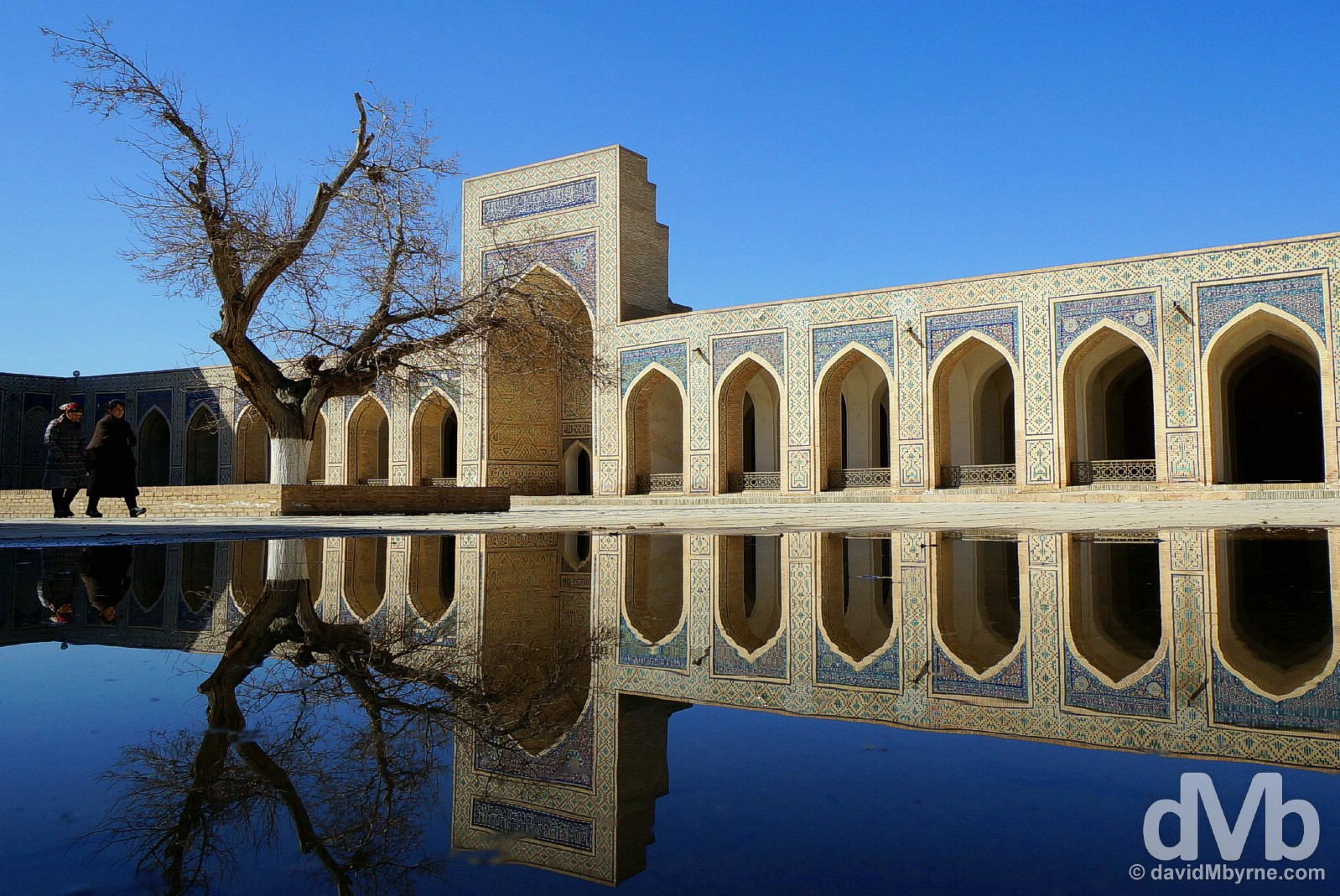
The expansive courtyard of the Kalon Mosque, void of anything when I visited except for a central tree (permanent) & a small puddle (temporary), can hold 10,000 people but for the majority of the time I was in here I had the whole place to myself. It was awesome. Built in the 16th century on the site of an earlier mosque destroyed by Genghis Khan (yes, he destroyed the mosque itself but not its accompanying minaret), it was only reopened as a place of worship in 1991 after the fall of the USSR – during the Soviet-era, when religious practice was outlawed, it was used as a warehouse. Reflections in the main courtyard of the Kalon Mosque in Bukhara, Uzbekistan. March 12, 2015.
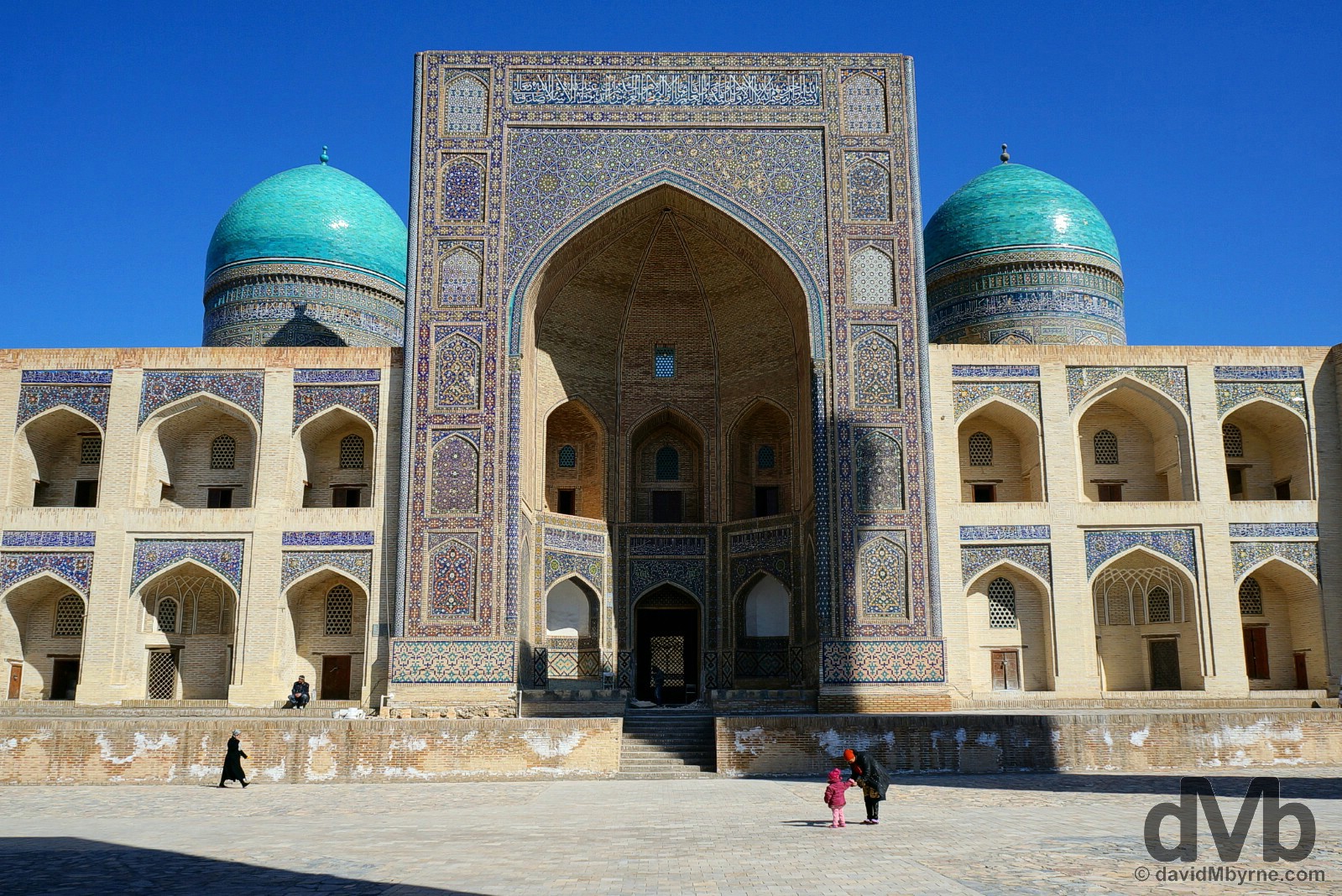
Probably Bukhara’s most striking building, the Mir-i-Arab Medressa sits opposite the Kalon Mosque. Still in use as a medressa (an Islamic school) today, meaning it’s interior is technically off-limits to tourists, its predominately blue tiled exterior looks great in bright sunlight. The shadow seen here on the massive central portal of the medressa’s façade is being cast by the Kalon minaret across the square. Mir-i-Arab Medressa, Bukhara, Uzbekistan. March 12, 2015.
Bukhara History
According to the legend Bukhara was founded by King Siavash, a legendary Persian prince from the beginnings of the Persian Empire. It was Central Asia’s religious & cultural heart in the 9th & 10th centuries before being razed by Genghis Khan in 1220. It became the capital of the so-called Bukhara khanate in the 16th century and once again became a center of arts and literature, attracting skilled craftsmen, poets and theologians. At this time the city boasted over 100 medressas and three times as many mosques. The Russians arrived in 1868 & the city became a protectorate of the tsar with the emirs still nominally in charge. That cozy relationship came to an end in 1920 when the Russians invaded the city, causing widespread damage to some of its fabled structures in the process, & in 1924 Bukhara was absorbed into the new Uzbek SSR, now know as Uzbekistan following independence from the USSR in 1991.
Ark
The Bukhara Ark is a citadel, a walled city-within-a-city, the fortified residence of the emirs, the city’s rulers until the Russians put an end to all that self-rule malarkey in 1920.
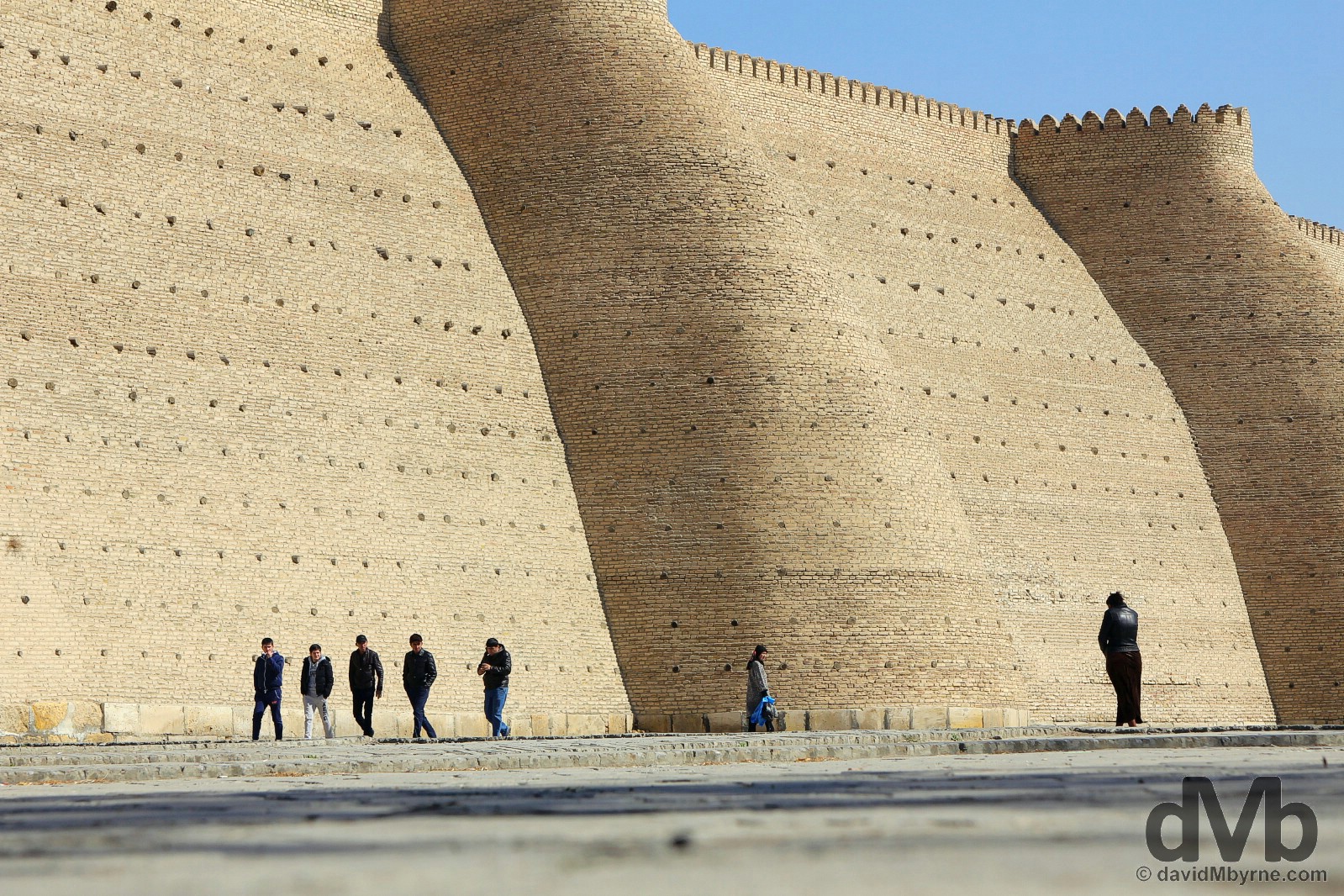
Bukhara’s oldest structure (it was built in the 5th century), today the Ark is mostly in ruins (those Russians again) but it somehow still manages to house various museums and display vague remnants of its past as an administrative centre & seat of power. All that is enclosed by the impressive external walls seen here, walls my camera preferred much more than the citadel innards. Taken from the vast space in front of the walls, the Registan, medevial Bukhara’s main square, the shifting shadows throughout the day meant the walls looked great from sunrise to sunset. Outside the towering walls of the Ark citadel in Bukhara, Uzbekistan. March 11, 2015.
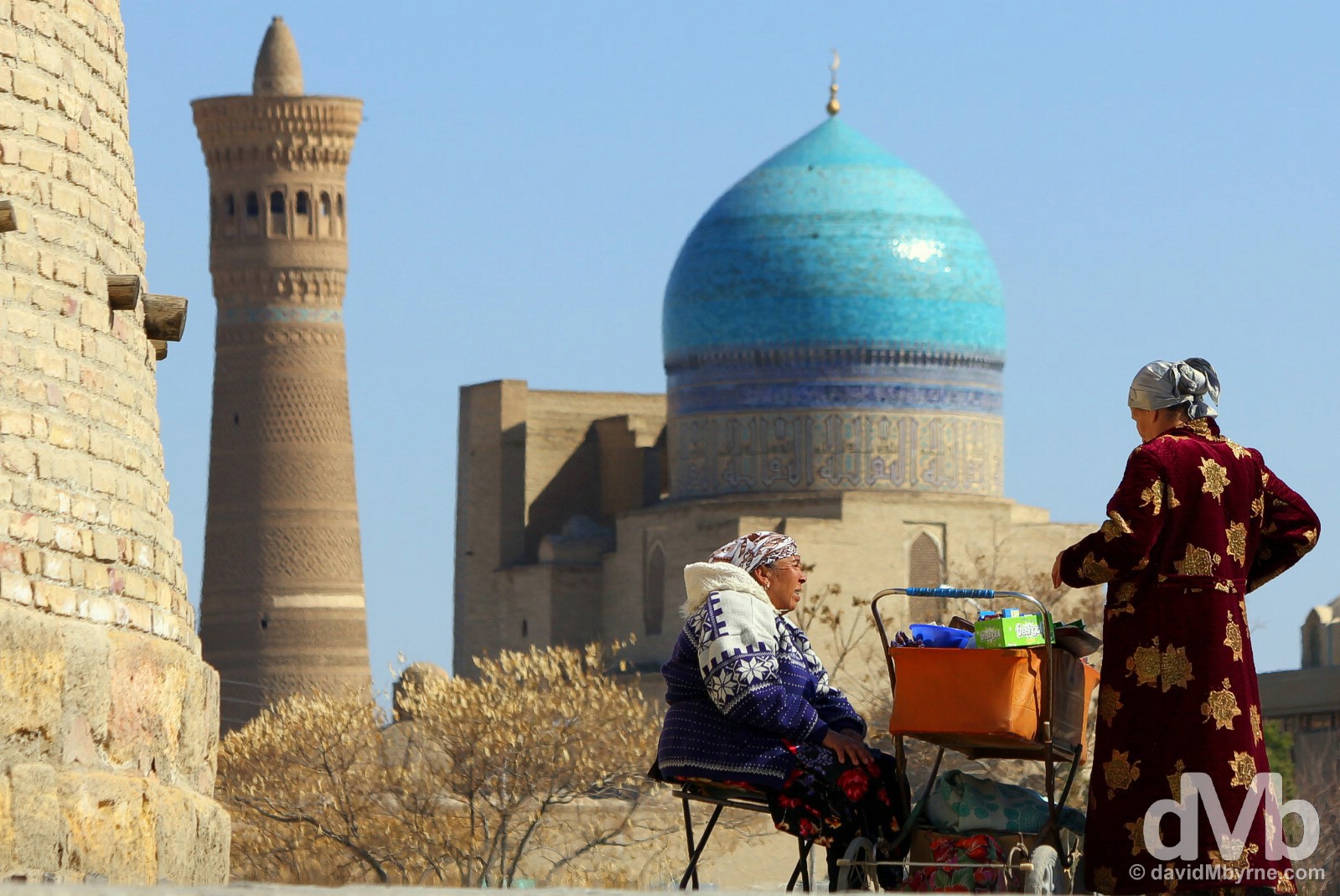
Conducting business by the walls of the Ark in the Registan in view the Kalon Mosque & Minaret. Bukhara, Uzbekistan. March 12, 2015.
Markets
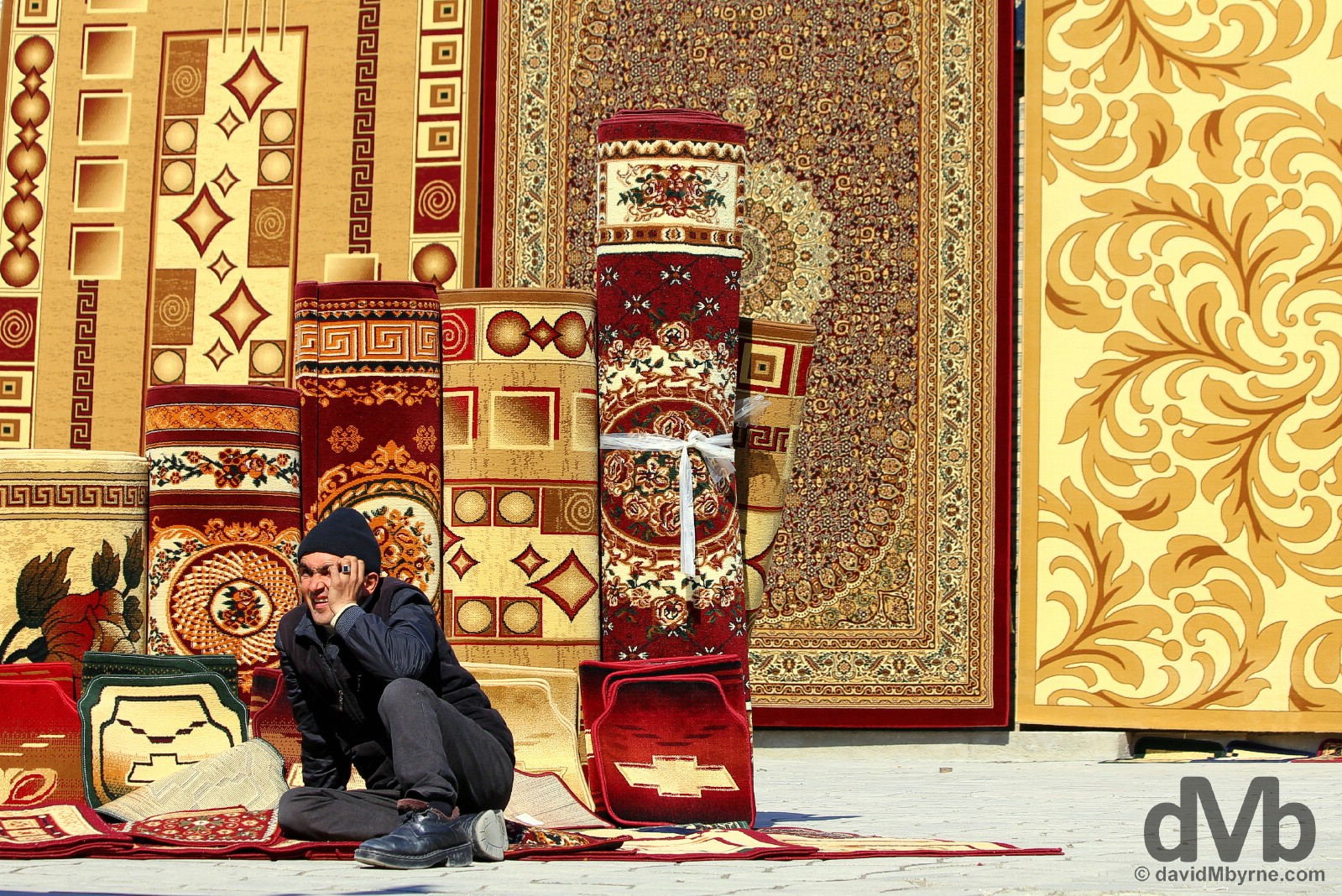
Bukhara’s old town is awash with markets a lot of which are traveller-orientated selling the expected tourist detritus. Set in heavily restored multi-domed arcaded market lanes, these were very quiet when I was in town (low season you see). This is a shot captured in Shahriston Market, a locals market set in a large space & selling mostly carpets (everyday) &/or specialty items such as clothes, handicrafts, jewellery etc. (assigned days). I had some jovial banter in here with some of the craftsmen, none of which thankfully tried to sell me a carpet. Shahriston Market, Bukhara, Uzbekistan. March 11, 2015.
Lyabi-Hauz
The center of the old city of Bukhara is the leafy, shady plaza Laybi-Hauz. Built in 1620, the plaza’s main element is a pool, one of dozens in the city but easily the most famous.
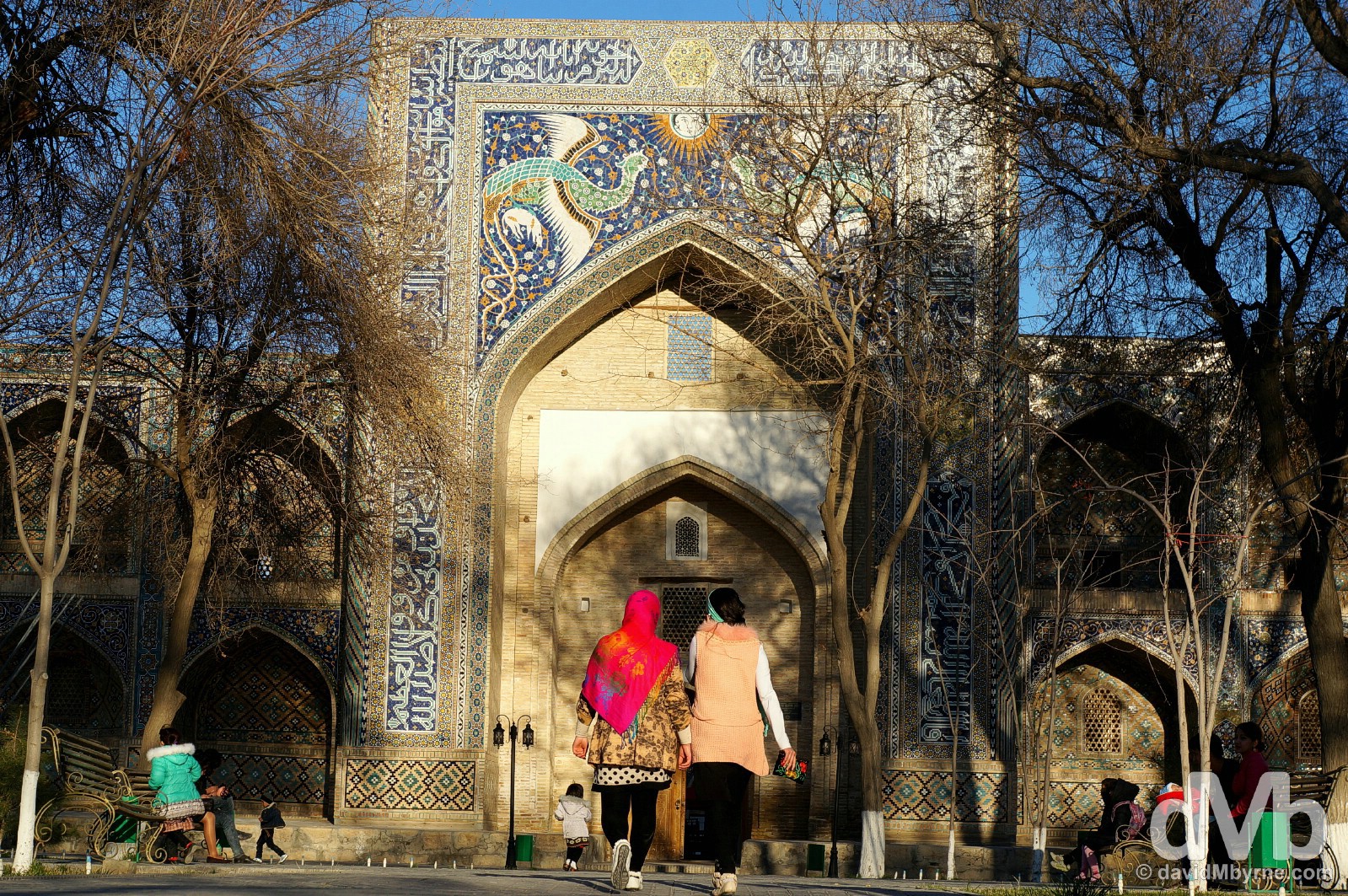
There are some monumental structures in or surrounding Lyabi-Hauz, one of which is the Nadir Devanbegi Medressa, seen here. It was built in the early 17th century originally as a caravanserai, a travellers inn, but was converted to a medressa in 1622. It’s most notable for the awesome exterior tilework on its façade depicting a pair of peacocks holding lambs either side of a sun with a human face, a depiction which, & just like the façade of the Sher Dor (Lion) Medressa in the Registan in Samarkand, goes against the Islamic prohibitions on the depiction of live animals. Lyabi-Hauz, Bukhara, Uzbekistan. March 12, 2015.
The Bukhara Bust-up
I caused a fracas today, the day I left Bukhara for Khiva further north. Of course I didn’t mean to (cause the fraca) but that didn’t prevent two taxi drivers going at it over who would get to have me sit beside them for the 6+ hours it’d take them to cover the 450 kilometres from Bukhara to Khiva, my present location and last stop in Uzbekistan (& Central Asia). No punches were thrown but it got heated & among the tirades there was plenty of pushing & shoving going on (of course they were ‘debating’ over who was going to be the recipient of the 70,000som (€17.5) the trip would cost me). Down boys.
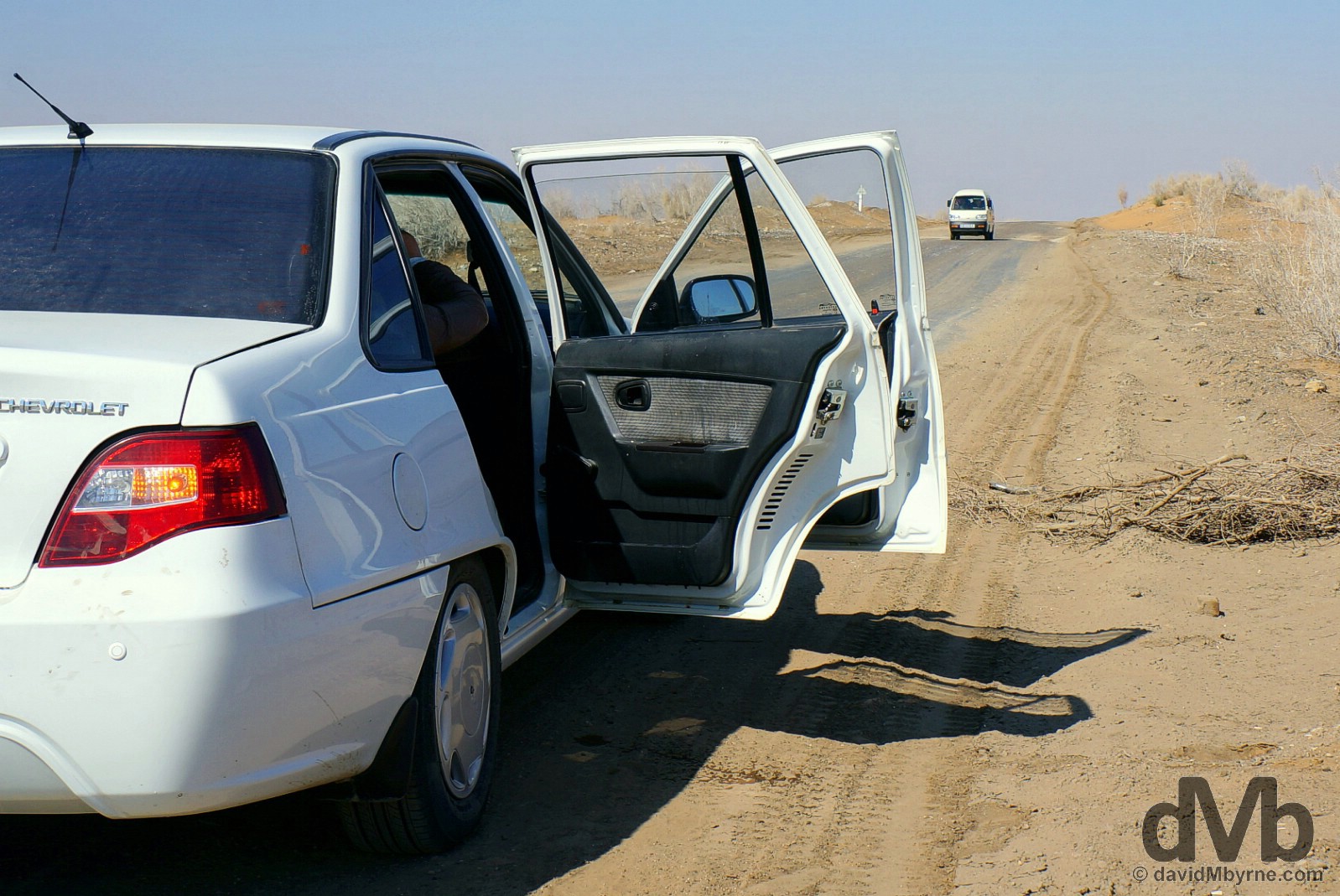
The trip itself north to Khiva was as mundane as they come – long straight stretches of nothingness as we passed through the seemingly endless Uzbek Kyzylkum desert. I took this picture on one of the stops en route forced upon us as one of my fellow passengers (4 to a car, 5 including the driver) was spewing her guts up by the side of the road – she couldn’t handle the incessant weaving to avoid the legions of potholes or the general roughness where there was no road at all. I haven’t seen one 4×4 on Uzbek roads but they sure need them. In the Kyzylkum Desert en route from Bukhara to Khiva, Uzbekistan. March 13, 2015.
THE BIG THREE - #3 - Khiva
Date || March 15, 2015
Location || Khiva, Uzbekistan ( )
)
It wasn’t lost on me over the last few days as I explored the fantastically preserved mud-brick lanes & structures of UNESCO World Heritage listed Khiva that the dusty former slave outpost wasn’t even on my original itinerary. I almost missed out on seeing what is the best preserved medieval city in Central Asia, if not the Islamic world, an entire walled city of traditional mud-baked architecture frozen in time in the Uzbek Khorezm oasis.
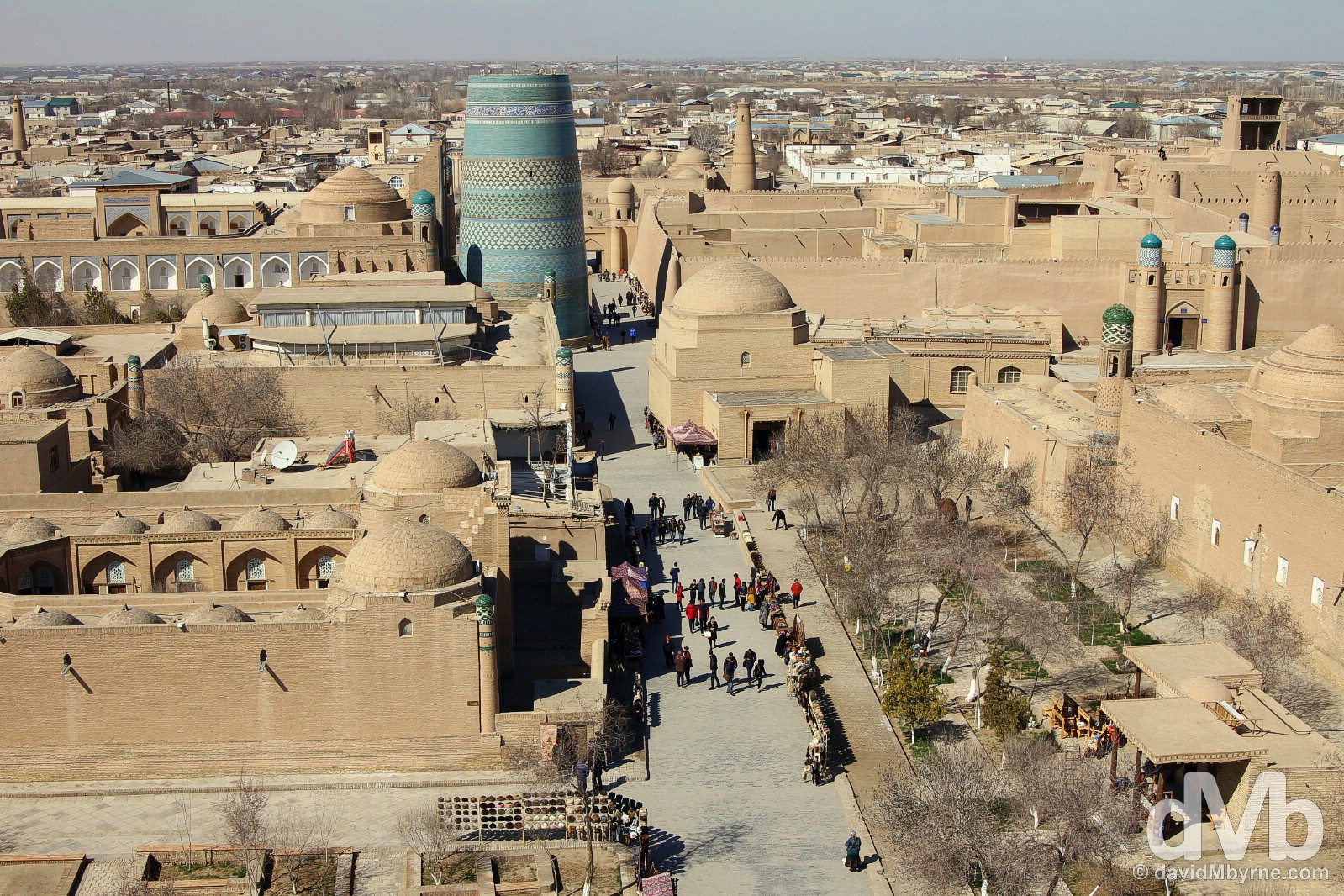
The view from the top of the Djuma Minaret looking towards the West Gate (Ota-Darvoza) & the landmark Kalta Minor Minaret of Itchan Kala, the mostly pedestrianised inner walled fortress of Khiva. Located in the barren Uzbek Khorezm Desert & synonymous with terrible desert journeys, slave caravans, & steppes infested with wild tribesmen, Khiva was the last resting-place of caravans before crossing the desert to Persia. Itchan Kala’s 10-metre high mud-brick walls enclose an area of 26 hectares which is home to 250 dwellings & 51 ancient monumental mud-brick structures – palaces, mosques, minarets, madressas, mausoleums, blue-tiled tombs, caravanserais and markets, all outstanding examples of Islamic architecture of Central Asia. It’s an amazing place to explore from ground level (or from atop the city walls), but from here, 47 metres up in the tight confines of the minaret of the Djuma Mosque, you get a great overview of the historic city’s monotone, mud-walled glory. Khiva, Uzbekistan. March 14, 2015.
History
Itchan Kala has a history that spans over two millennia. Originally a minor fort & side branch on the Silk Road, it became a state capital in 1592 while the town’s slave market would boom to become the largest in Central Asia. Although the settlement’s first dealings the Russians came in the early 18th century, it wasn’t sacked by the northerners until 1873, becoming a vassal of the tsar in the process. Just like Bukhara further south, Khiva was theoretically independent of the USSR & limped on under various despot emirs, ruling from the Itchan Kala Ark, before eventually being adsorbed fully into the Uzbek SSR in 1924.
– UNESCO commenting on Itchan Kala
City Walls & City Wall Gates
A 2.5 kilometre section of Khiva’s 18th century 10-metre high mud walls – from the West Gate right around to the East Gate – is accessible to the likes of me and ambling along them is a definite Khiva must-do.
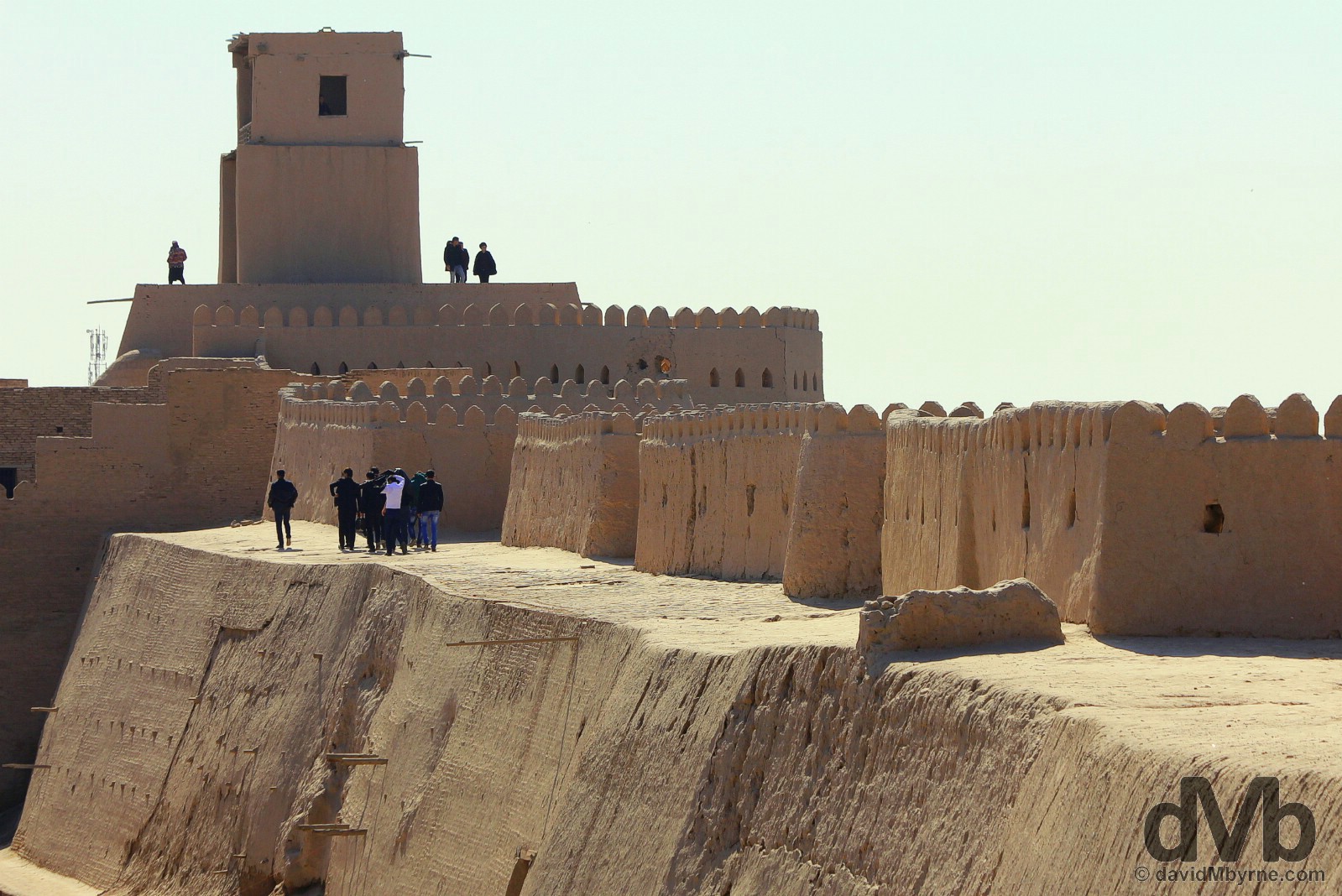
Walking atop the Itchan Kala city walls towards the Kuhna Ark Watchtower. Itchan Kala was built according to the ancient traditions of Central Asian town building, as a regular rectangle (650 by 400 meters) elongated from south to north and closed by mud-brick brick fortification walls that are up to ten meters high. Needless to say these kinds of structures don’t hold up well to the elements. That Itchan Kala & its walls look as good as they do today is thanks to various restorations that have been carried out over the years, restorations that have respected the traditional building techniques and the use of traditionally treated local materials such as baked brick, wood and stone. Khiva, Uzbekistan. March 14, 2015.
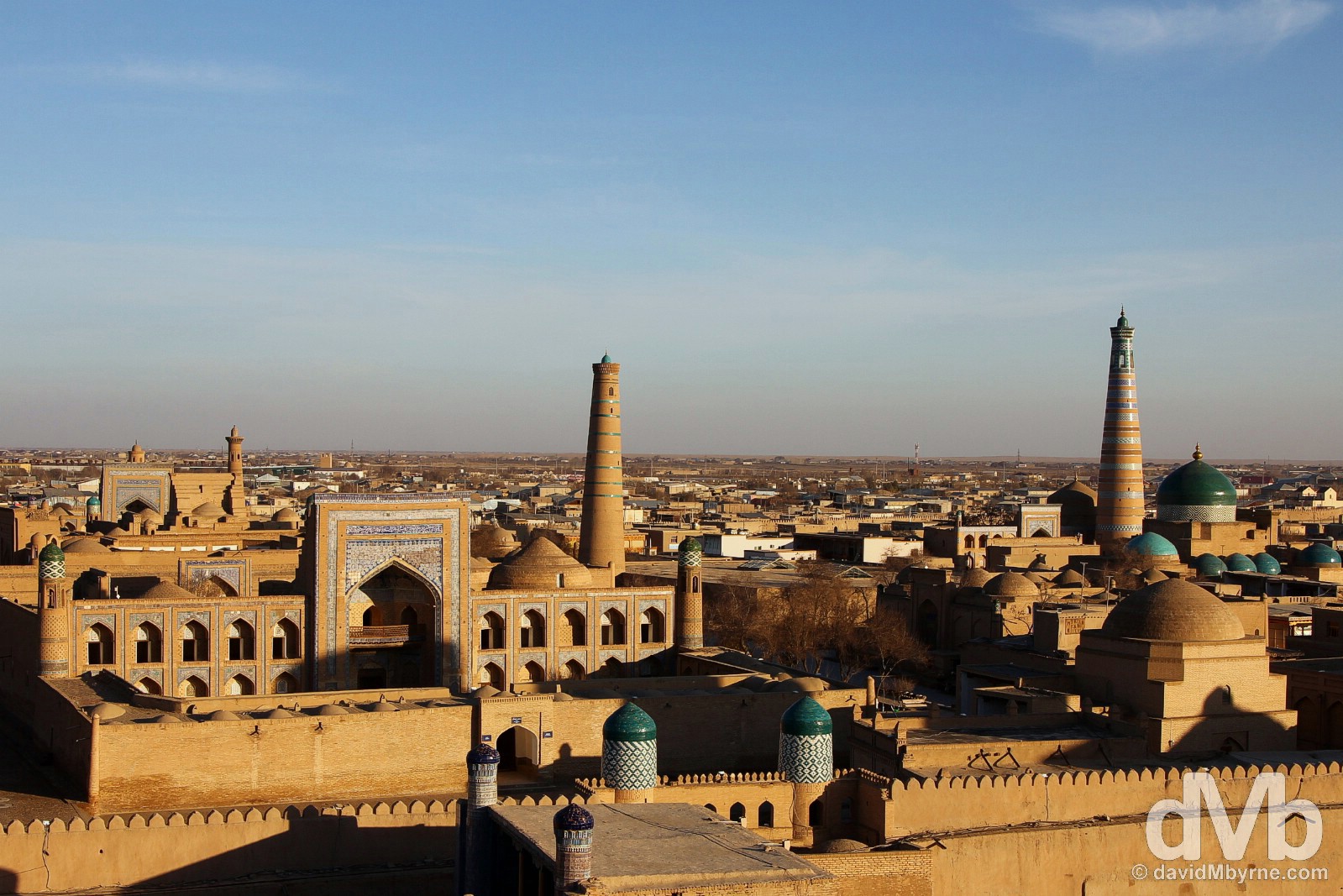
The Khiva Itchan Kala ensemble nearing sunset as seen from the Watchtower of the city’s Khuna Ark, the fortress-within-a-fortress & residence of the despot emirs of Khiva. First built in the 12th century, it was expanded in the 17th century. The highest section & the only original part of the Khuna Ark still standing today, the Watchtower is set against the city’s West Wall & needless to say it offers amazing views over Itchan Kala. This is the place to be at sunset or late in the afternoon as the setting sun shines on the mostly western-facing facades of the Itchan Kala structures. This image also shows Itchan Kala’s other minaret, the lighthouse-esque minaret of the Islom-Hoja Medressa (right). Built in 1910, it’s the city’s youngest Islamic monument, & at 57 metres is the tallest minaret in Uzbekistan. Khiva, Uzbekistan. March 14, 2015.
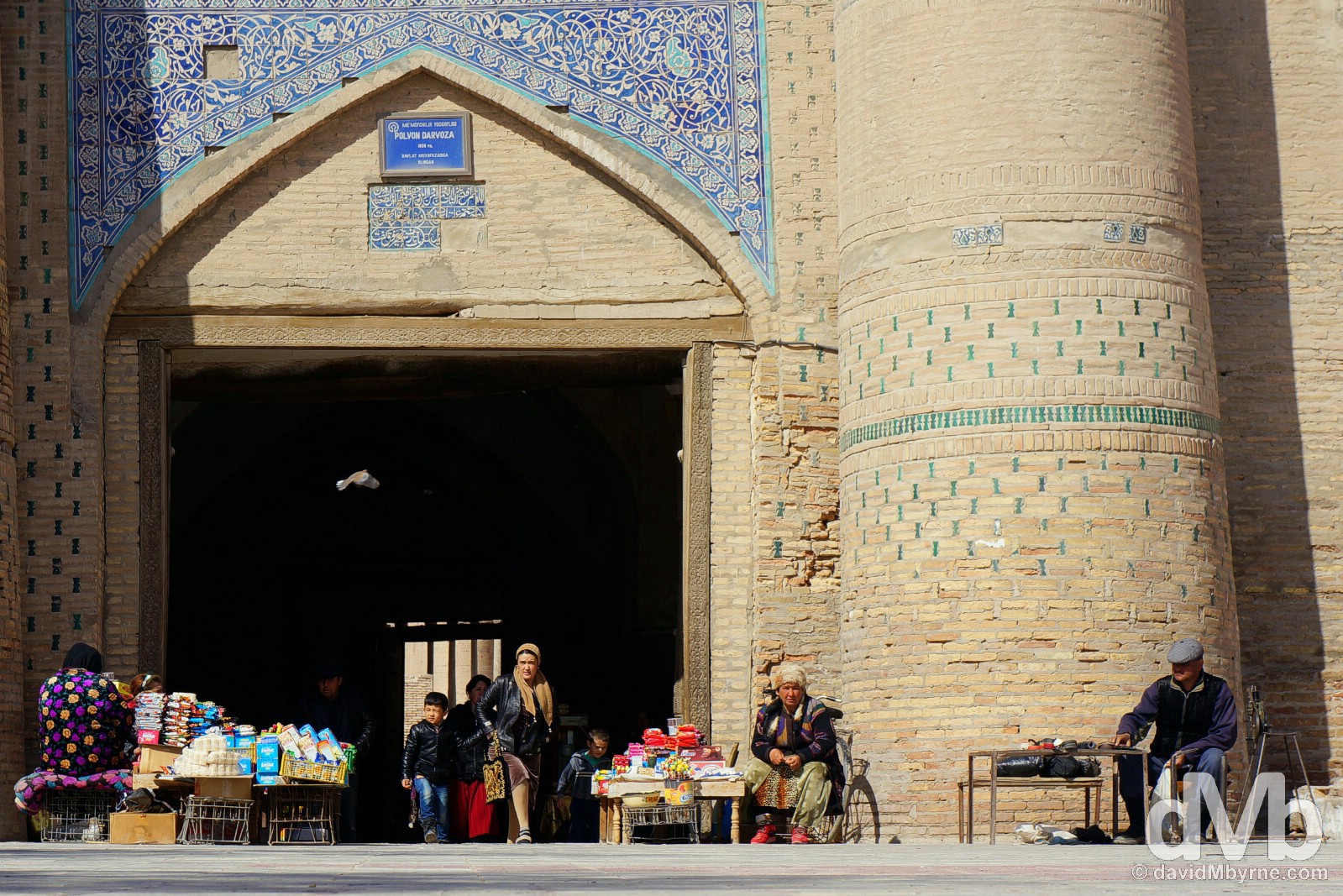
Sitting at Itchan Kala’s East Gate (Polvon-Darvoza) near the entrance to the city’s Dekhon Bazaar. Khiva’s mud-brick walls have 4 gates corresponding to the 4 cardinal points – North (Bogcha-Darvoza), South (Tosh-Darvoza), East (Polvon-Darvoza), & West (Ota-Darvoza). Vehicular traffic can enter Itchan Kala through the North & South gates but its foot traffic only at the busier East & West gates. Khiva, Uzbekistan. March 14, 2015.
A few other captures from my time in Khiva.
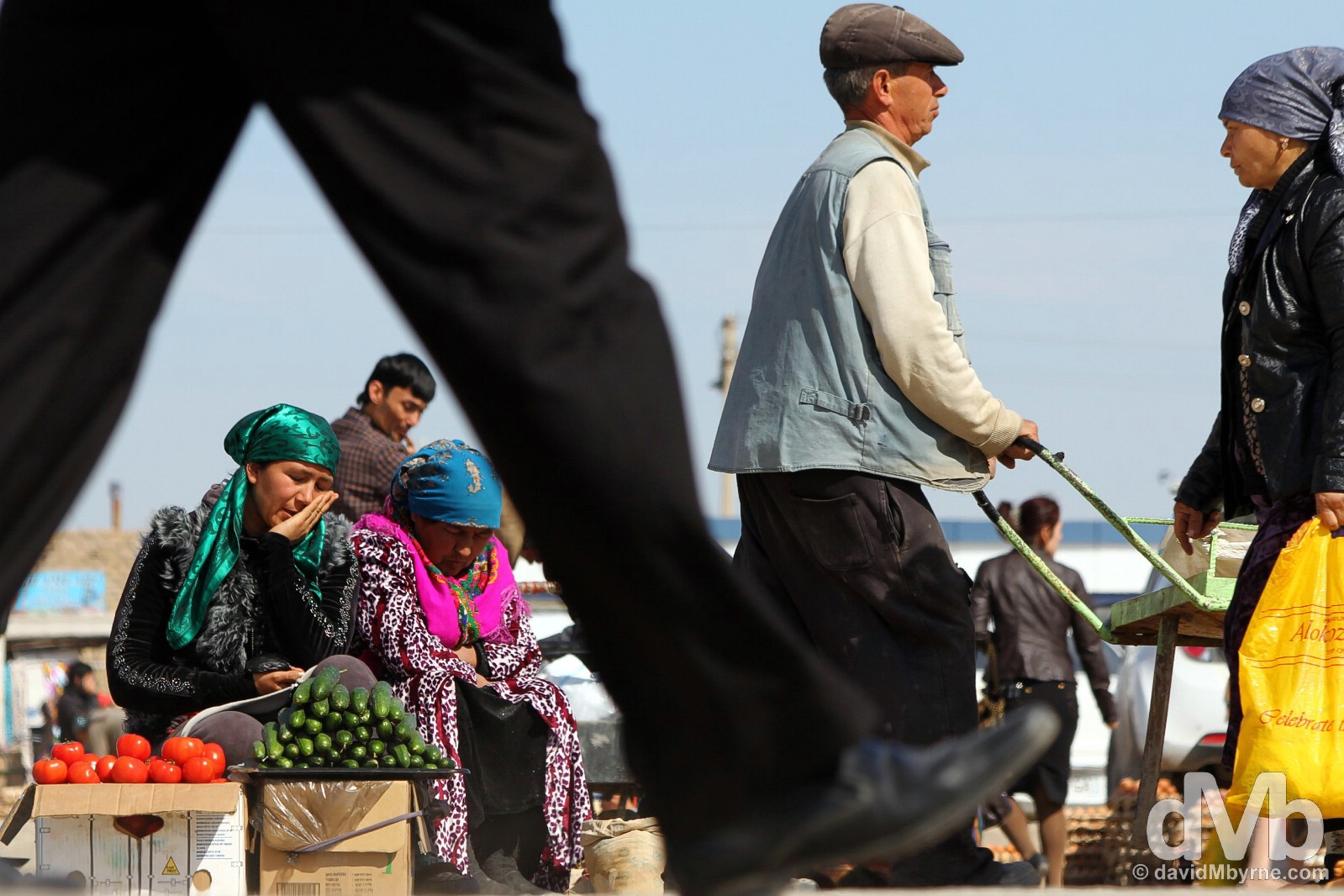
Khiva’s main bazaar was for centuries the biggest slave market in Central Asia. Lack of slaves these days means the city’s Dekhon Bazaar is now restricted to stocking the Central Asia market stalwarts of live & dismembered animals, dodgy ‘beauty’ products, assorted spices & vegetables. It’s a colourful, busy place to be. And photogenic too. Dekhon Bazaar in Khiva, Uzbekistan. March 14, 2015.
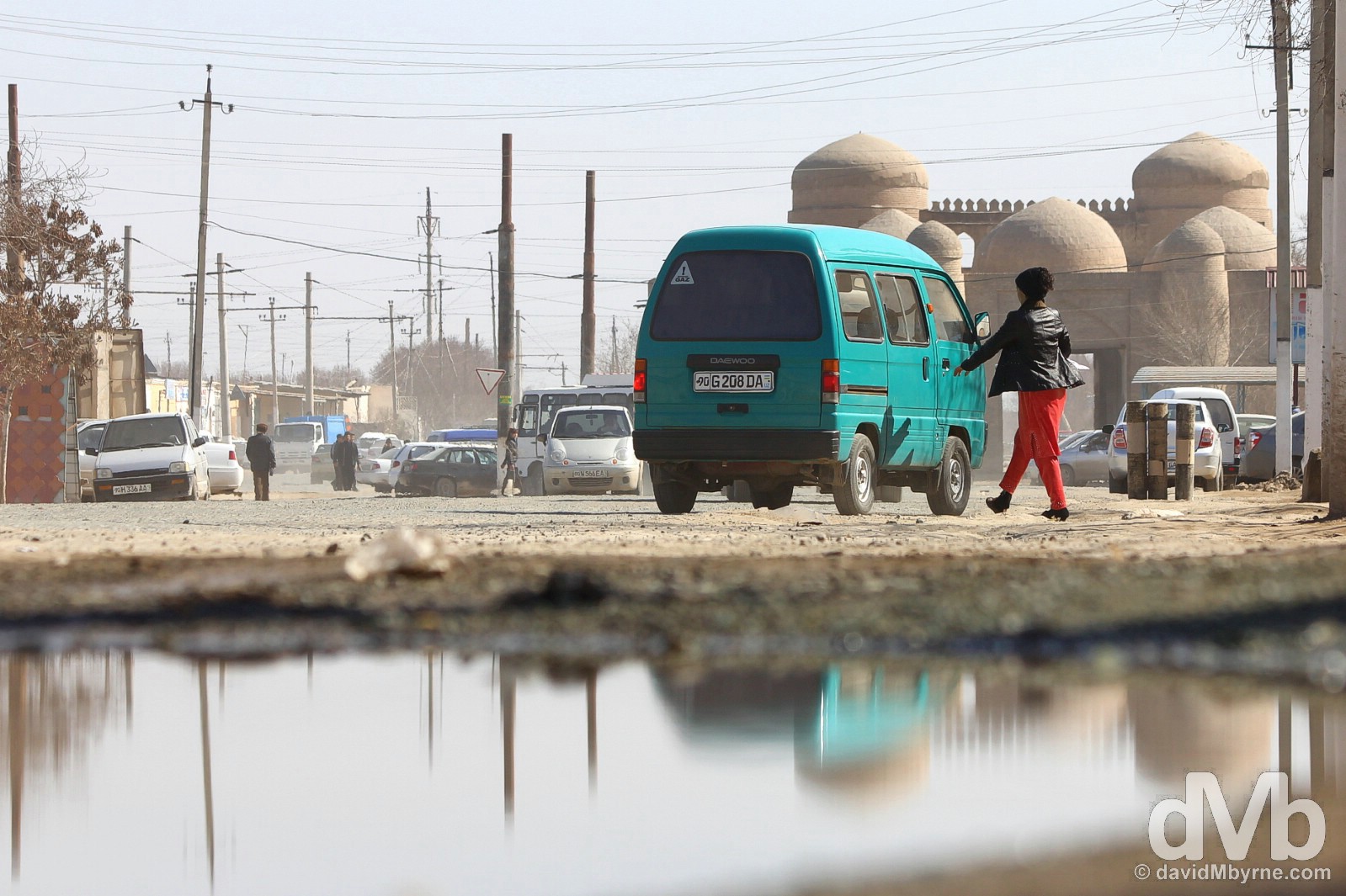
There’s dust here. Lots of it. Looking towards the Koy Darvoza Gate that rests outside the East Gate (Polvon-Darvoza) of the Khiva city walls. Khiva, Uzbekistan. March 14, 2015.
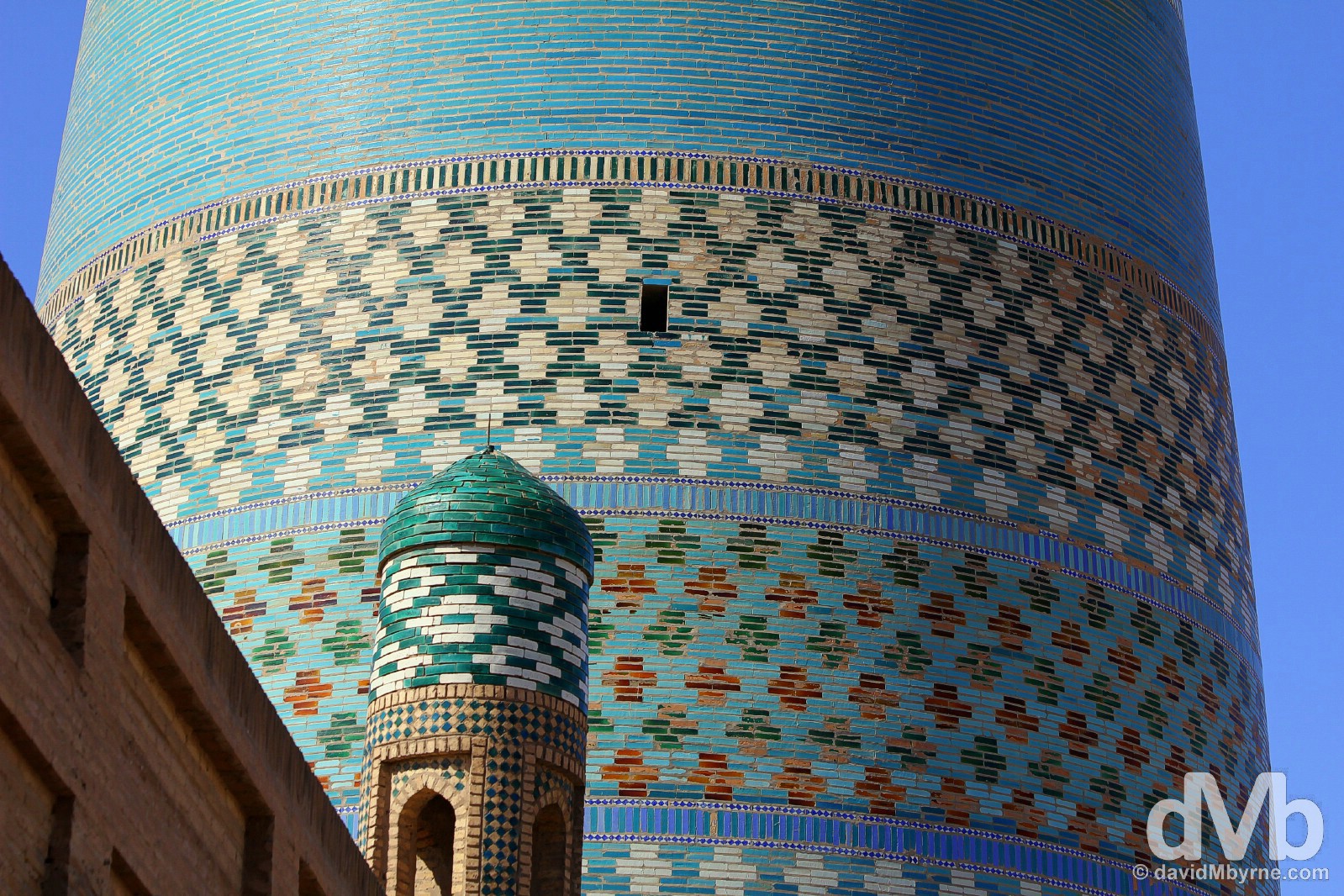
Detail of the Katla Minor Minaret, Khiva’s most iconic sight. Covered in turquoise tiles, the stumpy structure that stands today is the unfinished attempt at a full-blown minaret – construction began in 1851 but its builder, Mohammed min Khan, died 4 years later and thus the structure was never finished. Khiva, Uzbekistan. March 14, 2015.
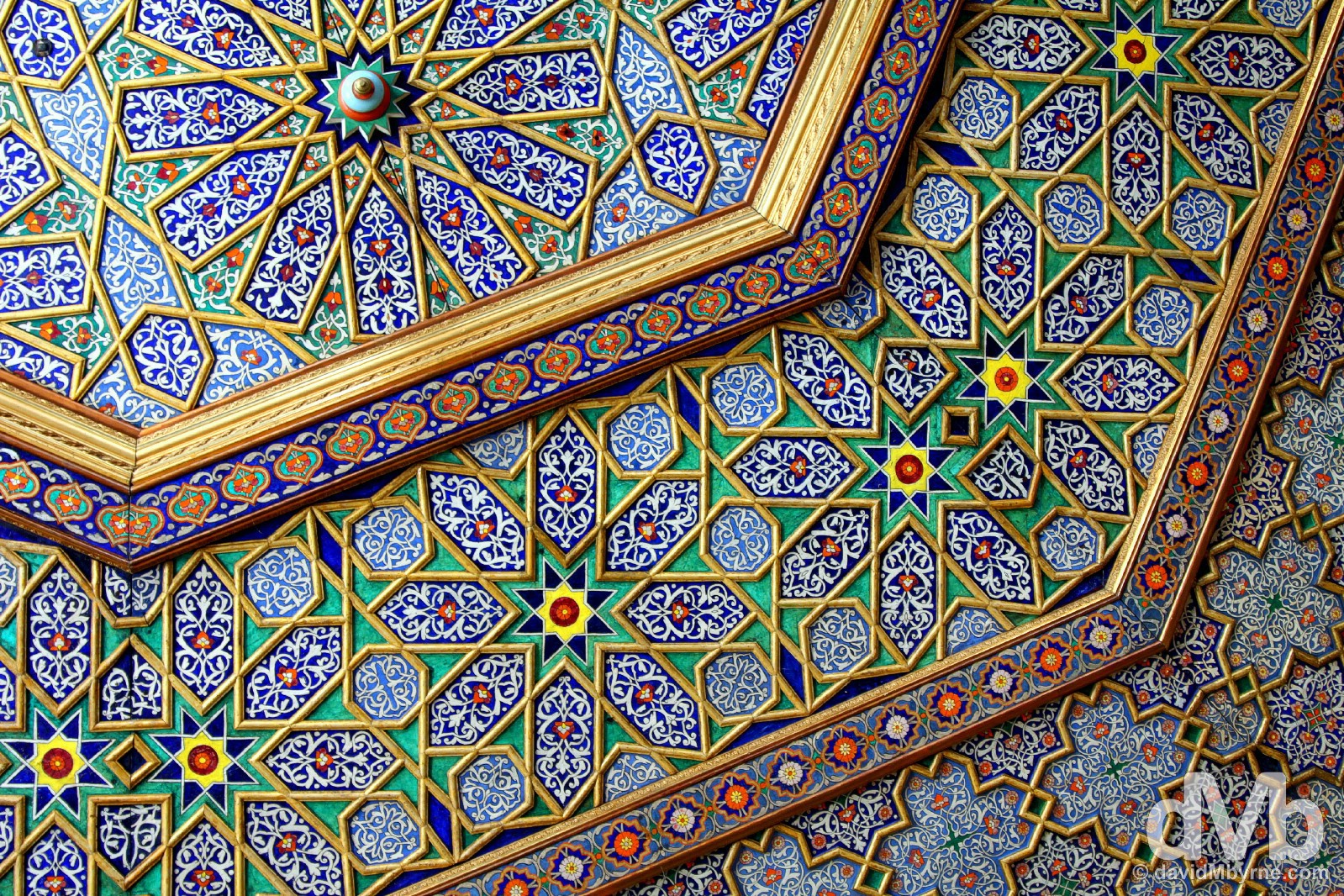
Amazing ceiling detail in the Palace of Narallabay/Isfandiyar Palace. Built between 1906 & 1912 as a favoured hangout of the then Khiva emirs, it a lavish place full of gold-embroidered ceilings, coloured tiles, 4-metre high mirrors, & massive chandeliers. Khiva, Uzbekistan. March 15, 2015.
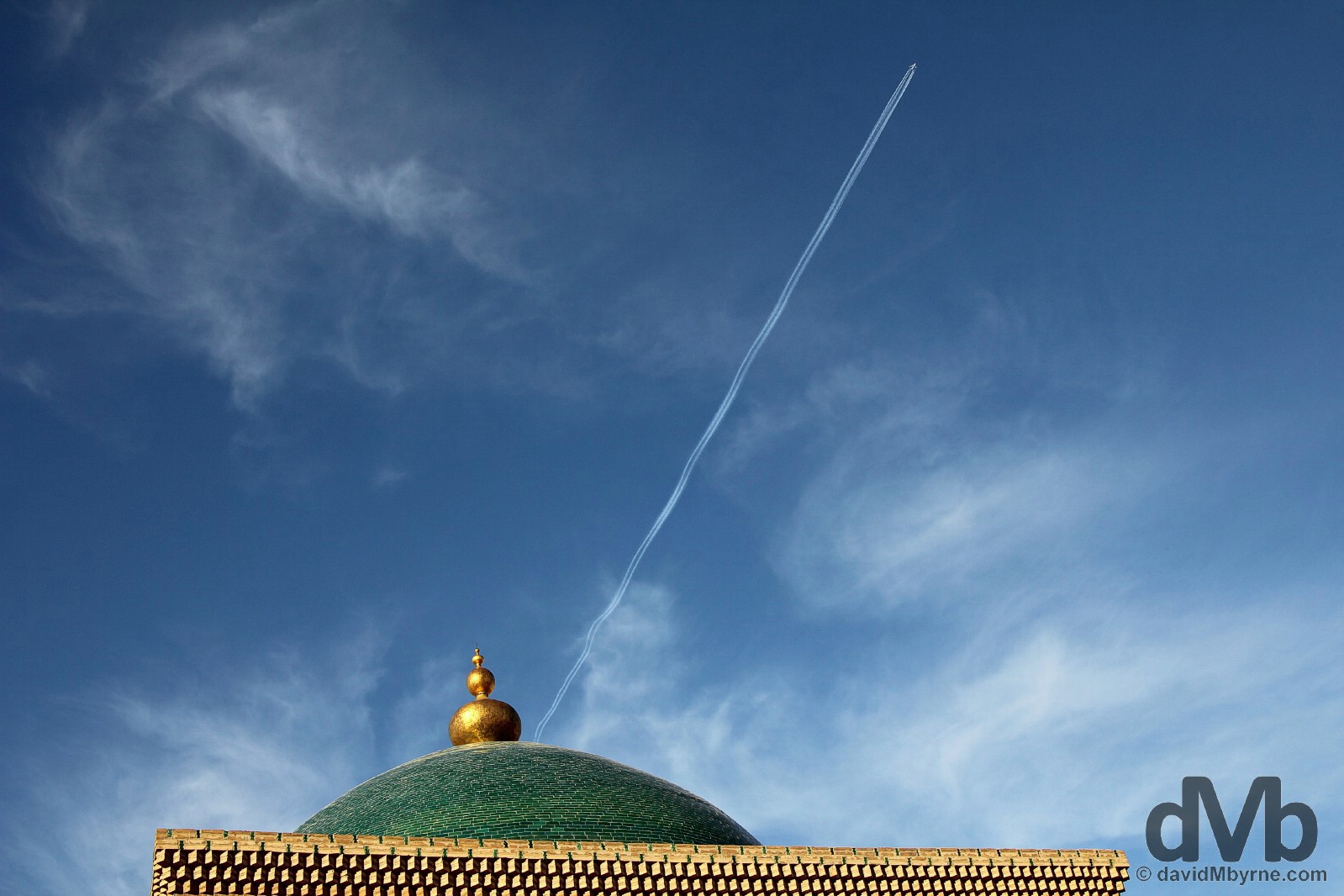
Gorgeous skies above the dome of Khiva’s Pahlavon Mahmud Mausoleum. The quiet courtyard in here is one of the city’s most beautiful spots. When I happened to be poking around the skies above me were quite beautiful too – it was late in the afternoon. Khiva, Uzbekistan. March 14, 2015.
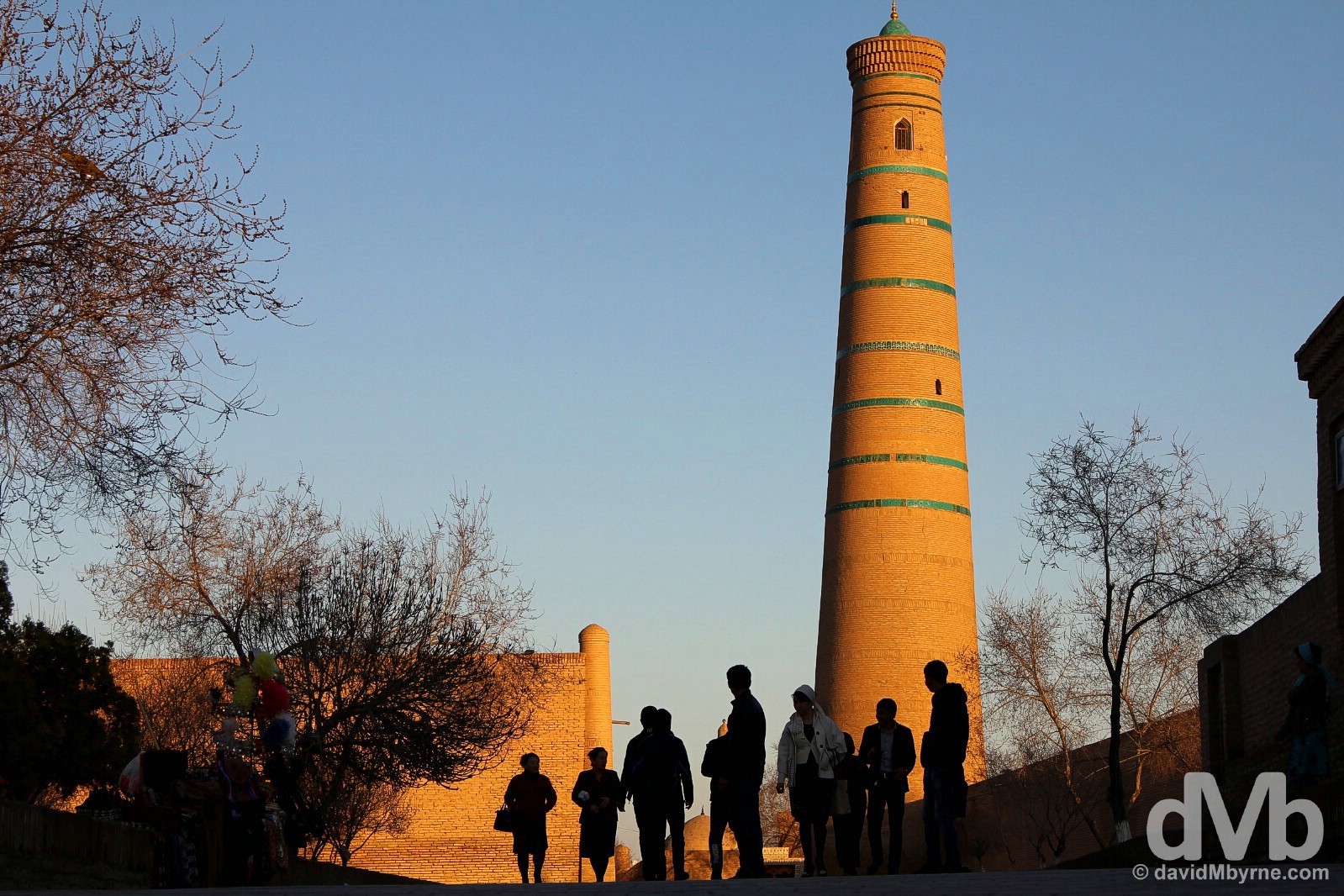
Silhouettes & the Djuma Mosque Minaret as seen from Pahlavon Mahmud in the pedestrianised centre of Khiva. This was my very first capture in Khiva. It was taken shortly after arriving in the city from Bukhara, 450 kilometres south from here across the barren Uzbek Kyzylkum Desert. And yes, the minaret does have a pronounced lean. Khiva, Uzbekistan. March 13, 2015.
THE CAPITAL - Tashkent
Date || March 17, 2015
Location || Tahskent, Uzbekistan ( )
)
I’m back in the Uzbek capital of Tashkent having arrived into the city this morning off the 19-hour overnight sleeper train from Urgench, a short taxi ride from Khiva. Arriving back here brought an end to my 10-night loop through the Uzbek Big Three of Samarkand, Bukhara & Khiva. And very shortly it’ll bring an end to my jaunt through the region as tonight is my last last night in the city, my last night in Uzbekistan, my last night in Central Asia.
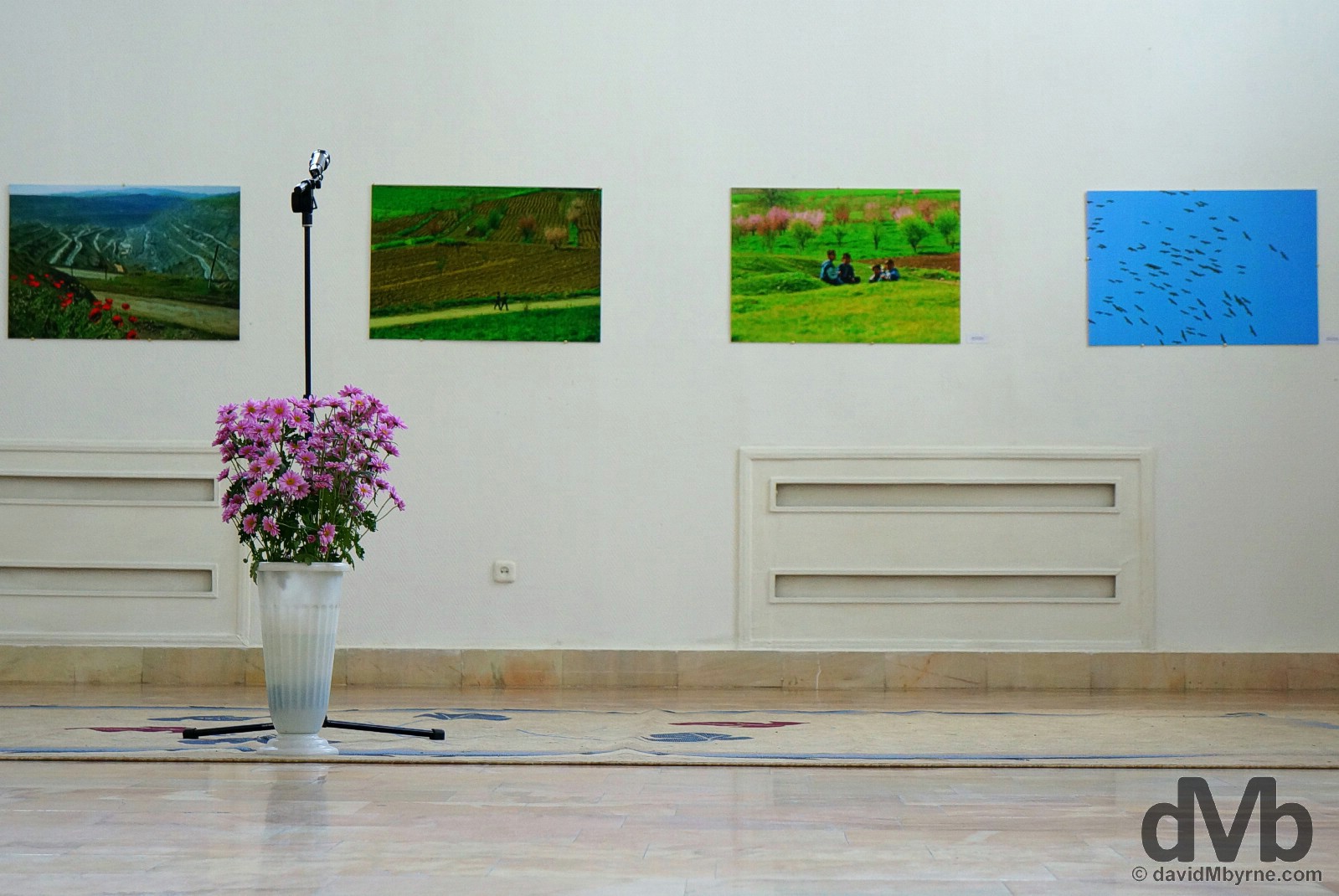
House of Photography of the Academy of Arts of Uzbekistan in Tashkent, Uzbekistan. March 17, 2015.
Today, St Patrick’s Day, was a quiet day in Tashkent. I visited a few museums, including the House of Photography, a bucket list holdover from my first 3-night say in the city before setting out on my Big Three loop. There wasn’t much to photograph today (I didn’t even bring the ‘big’ camera with me), just the House of Photography & the metro system that I utilised to get there.
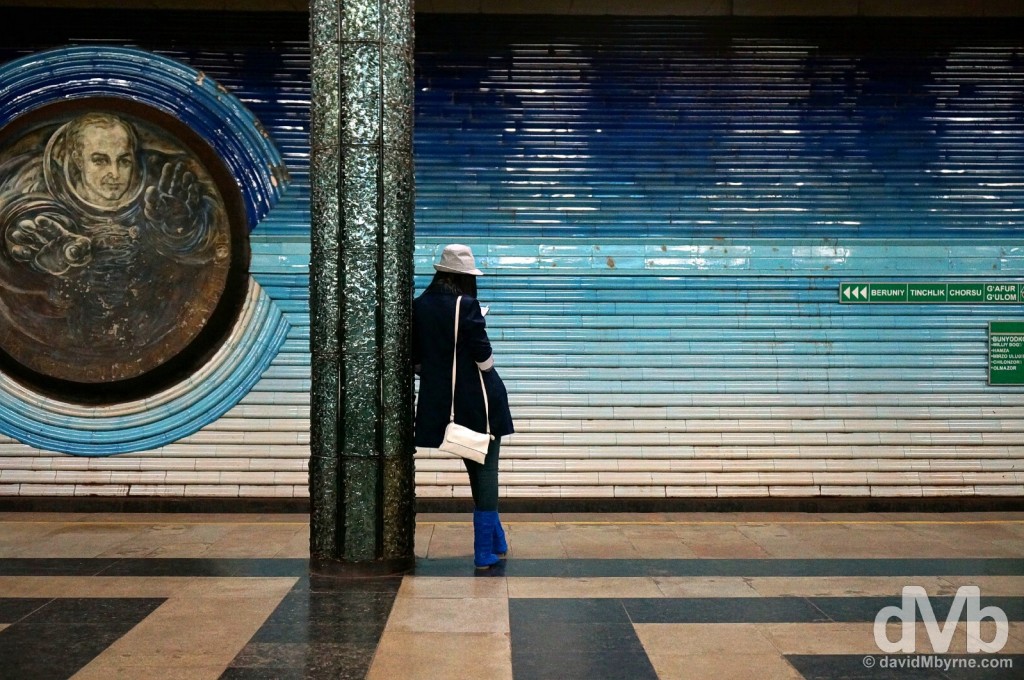
Photography is strictly prohibited in the Tashkent metro system, a run-of-the-mill Soviet creation of deep, deep stations with tight security & uniquely decorated platforms. I’d resisted pulling my camera out on my first visit to the city (I stuck out enough as it is) but very discreetly did so today. Kosmonavtlar Metro Station of the Uzbekistan Line of the metro in Tashkent, Uzbekistan. March 17, 2015.
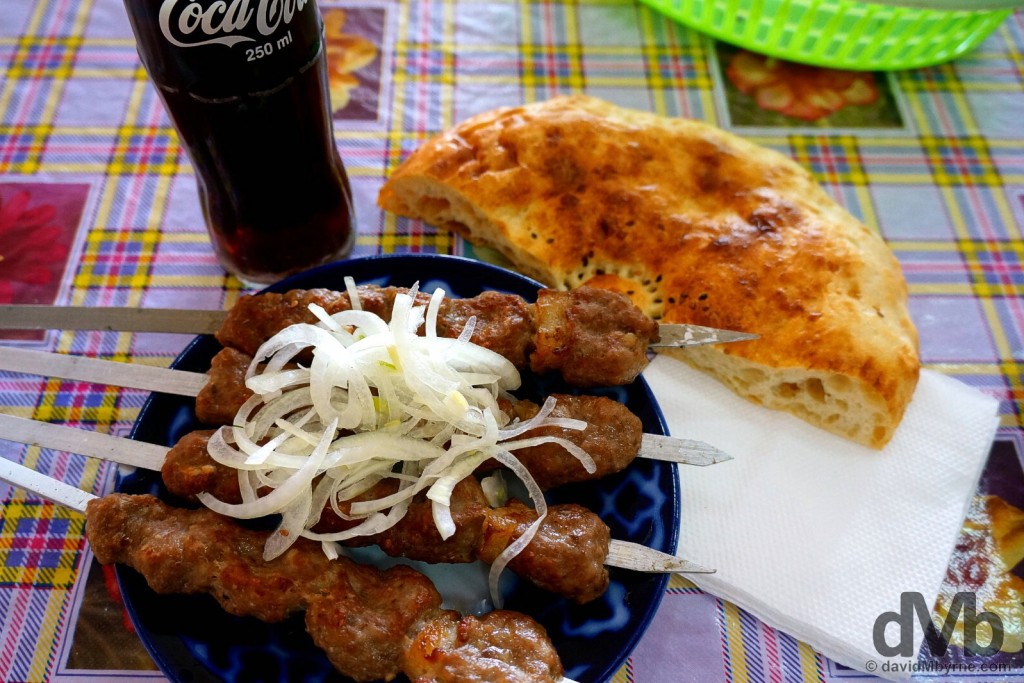
Lunch today in Tashkent, & on many other occasions elsewhere in Uzbekistan over the past few weeks. Simple BBQ/grill eateries abound all over Uzbekistan with the staple being grilled meat skewers with sliced onion served with bread (& an optional coke). Surprisingly simple, surprisingly tasty & surprisingly filling. Chorsu Bazaar, Tashkent, Uzbekistan. March 17, 2015.
Of course I’d photographed Tashkent previously. So here are a few old pictures from the city, holdovers from my first visit & pictures taken at a time when all I knew of Uzbekistan was its surprisingly pretty capital, Central Asia’s largest urban centre with a population of some 2.2 million.
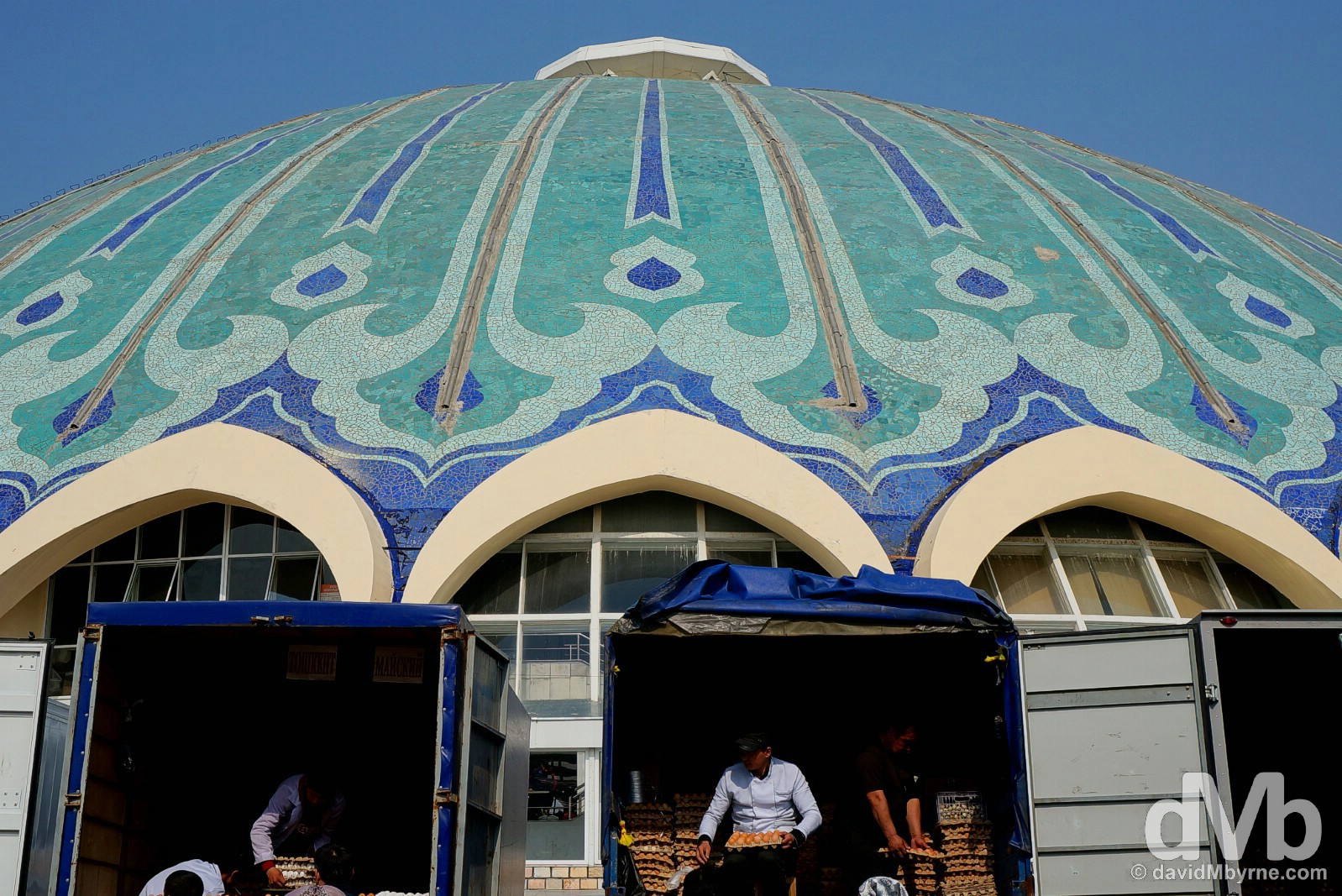
Selling eggs out the back of a van in Chorsu Bazaar. I spent a lot of time in here as it was just around the corner from my B&B. I also did all my black-market money-changing here. The centerpiece of the city’s most famous farmer’s market is its massive blue & green tiled dome built in the traditional style (a chorsu is a building covered by a central dome & surrounded by shops and workshops covered by smaller domes) and under which you find the usual array of market stalls & the accompanying cacophony of market noise. Chorsu Bazaar, Tashkent, Uzbekistan. March 5, 2015.
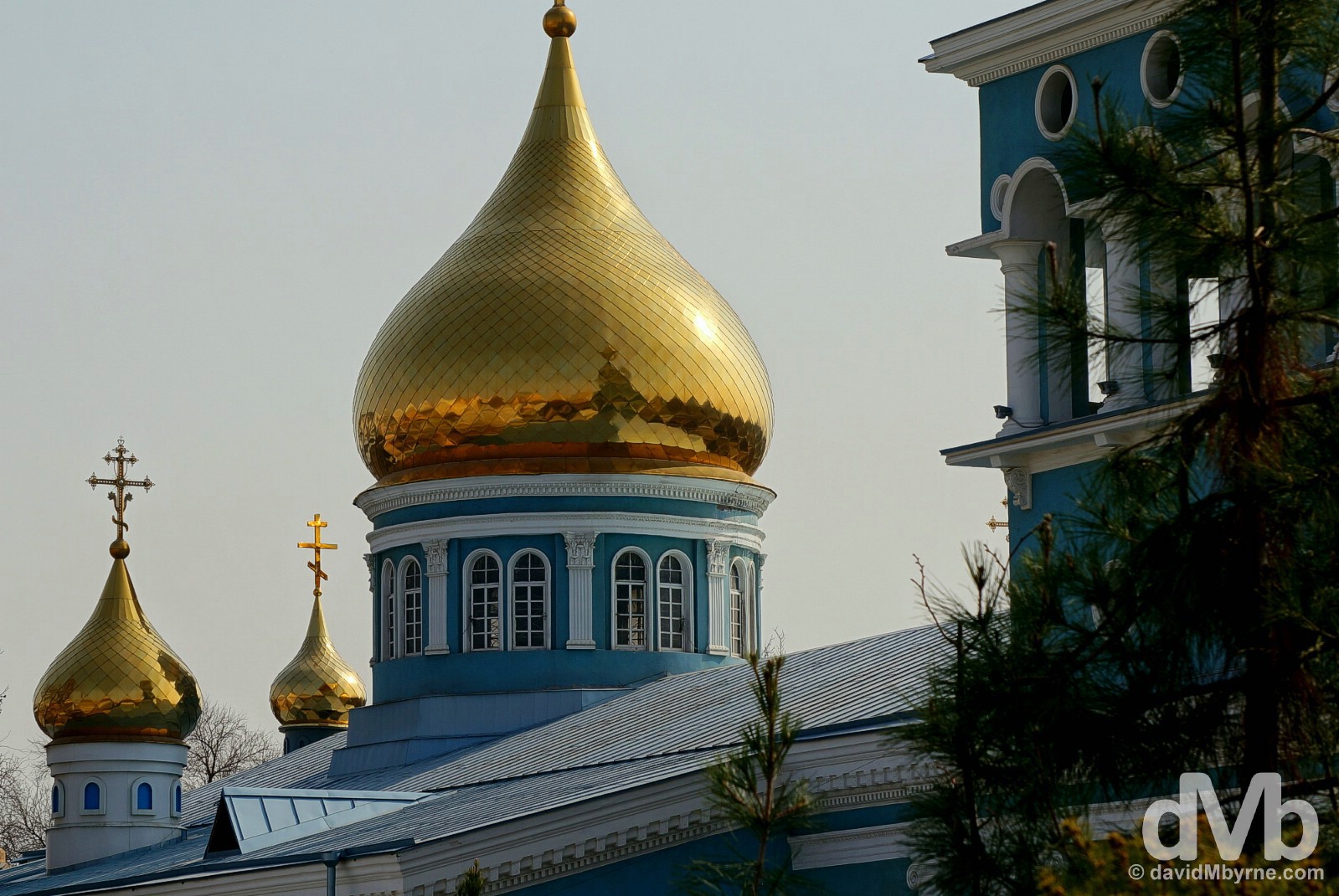
Assumption Cathedral, built in 1958, is the biggest of Tashkent’s 4 Orthodox churches. I didn’t even go inside, instead just snapping its glorious gold onion domes from the outside when passing. I guess I’ve seen my fill of Russian architecture. Tashkent, Uzbekistan. March 5, 2015.
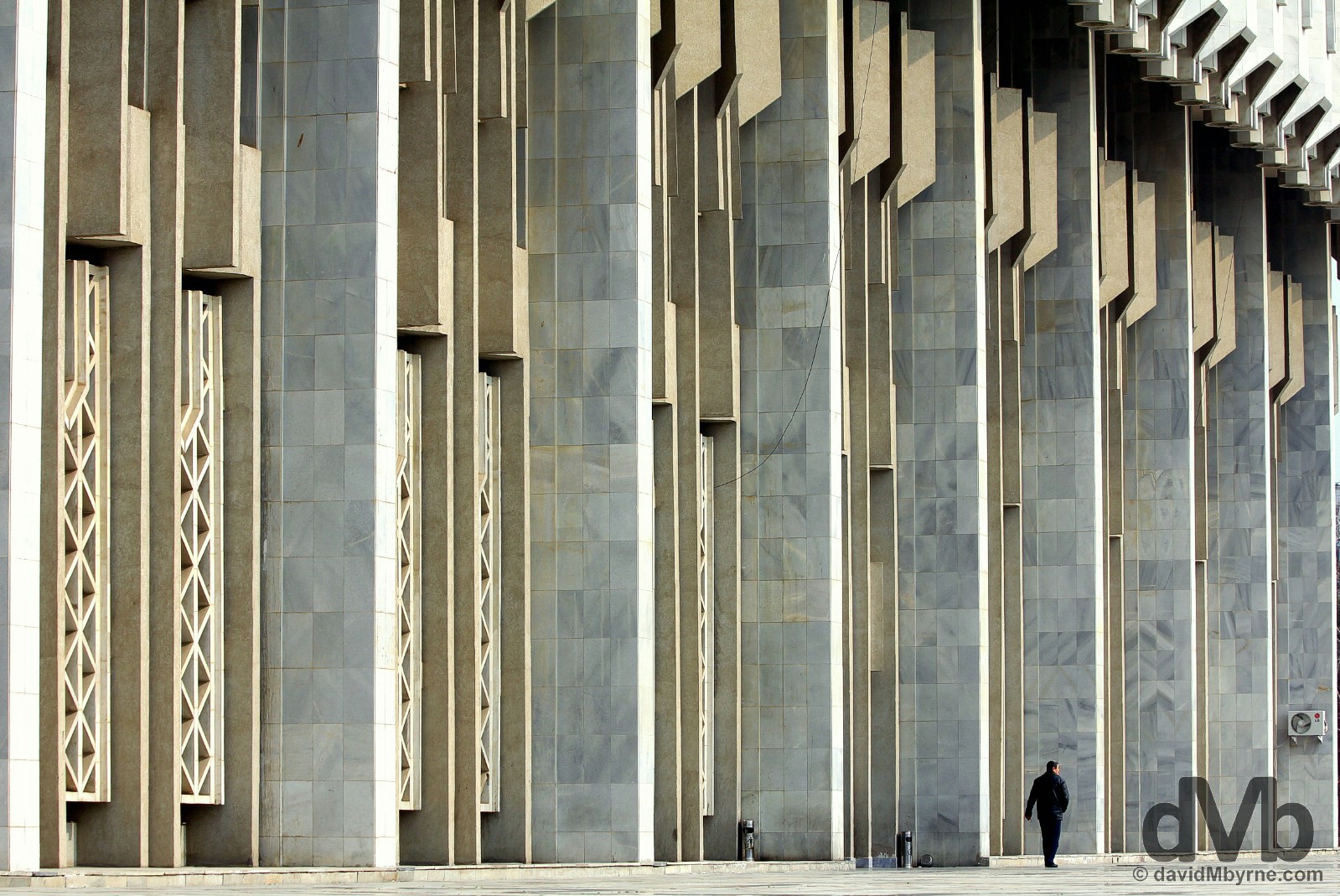
OK, just one more from the Soviets & the last Russian monstrosity I’ll be posting from Central Asia. And what a monstrosity it is. This is the city’s Istiklol Palace, formally the People’s Friendship Palace, in the city’s Navoi Park, the place to go in Tashkent if you’re a fan of boxy Soviet-era architecture. Tashkent, Uzbekistan. March 6, 2015.
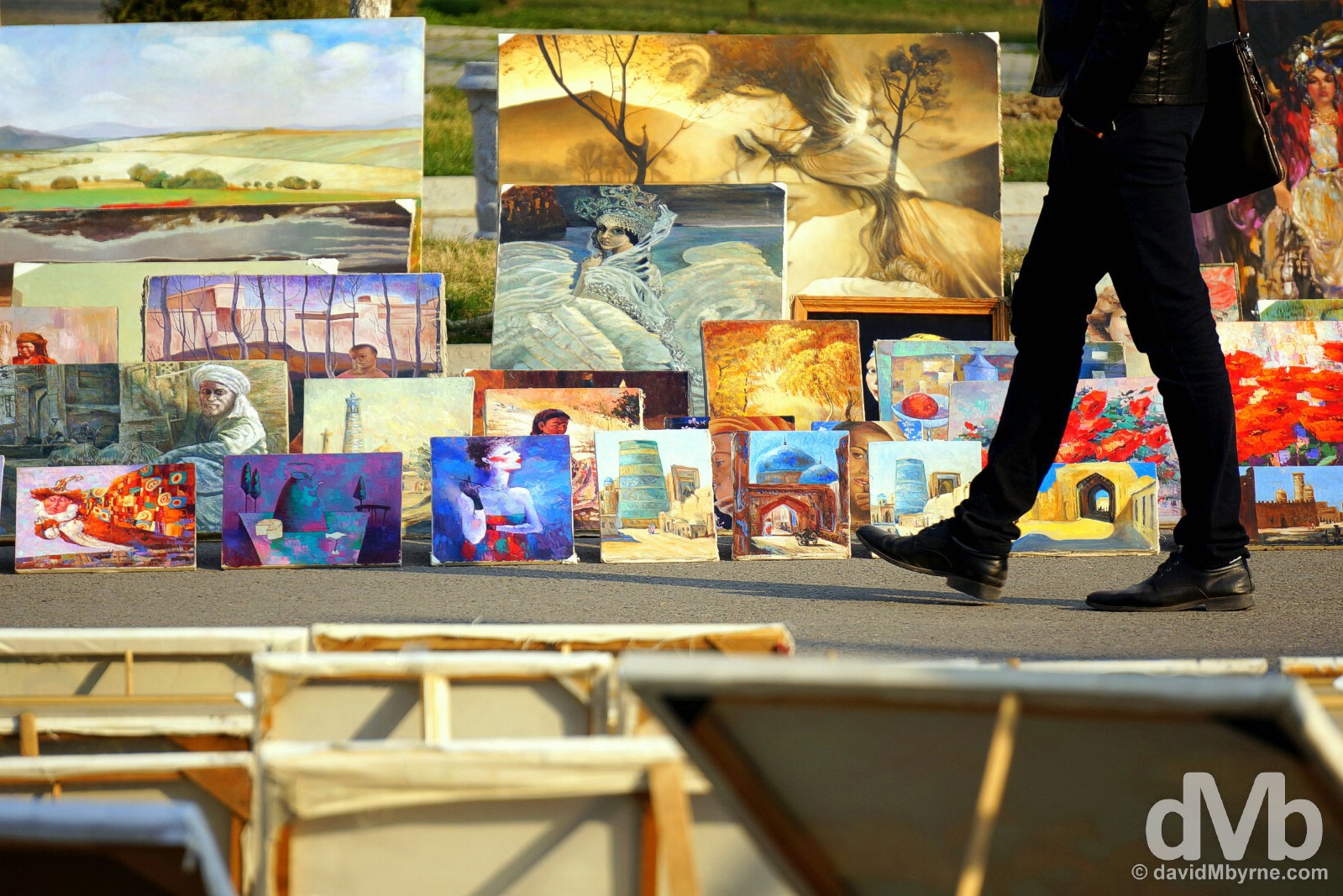
Art for sale on Sayilgoh (Broadway) in central Tashkent, Uzbekistan. March 5, 2015.
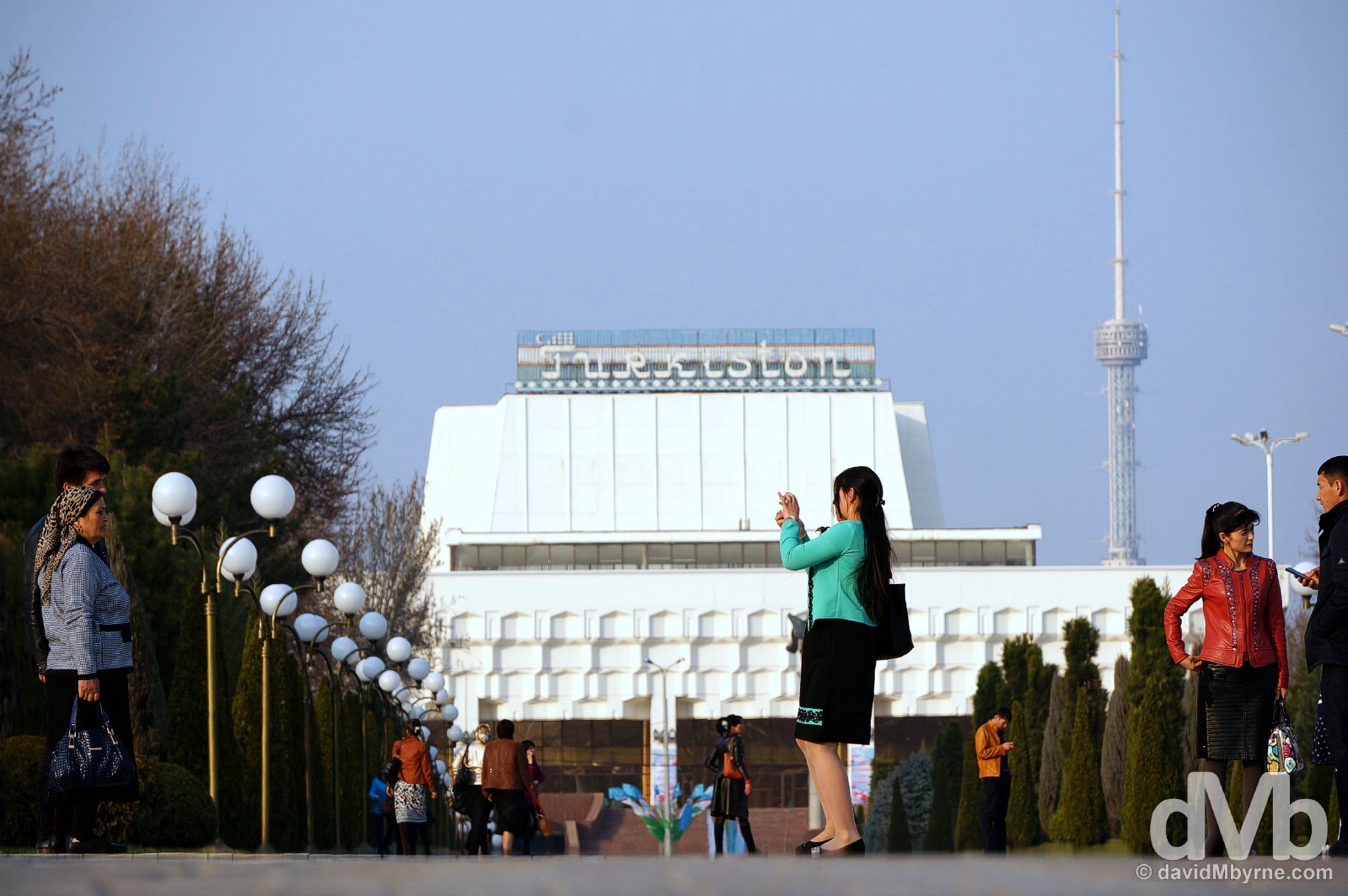
Mustaqillik Maydoni (Independence Square) is not too far from the polished ceremonial centre of the city, Amir Timur Maydoni (Timur Square), and is a nice relaxing place to visit surrounded by some impressive buildings. Tashkent, Uzbekistan. March 5, 2015.
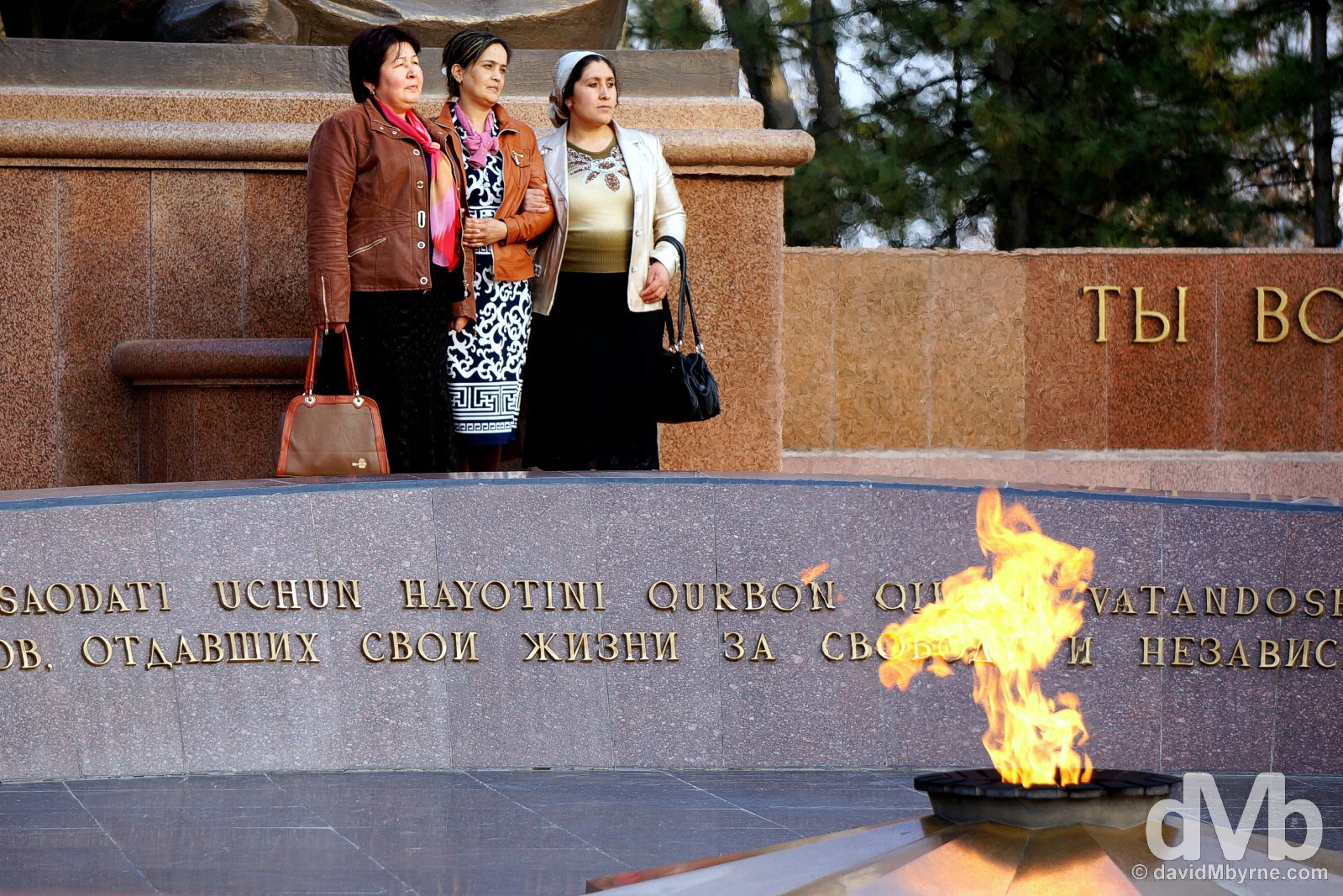
Also in Mustaqillik Maydoni (Independence Square) is the gorgeous Crying Mother Monument. Built in 1999 & boasting the requisite eternal flame, the monument honours the 400,000 Uzbek soldiers who died fighting in World War II. Mustaqillik Maydoni (Independence Square), Tashkent, Uzbekistan. March 5, 2015.
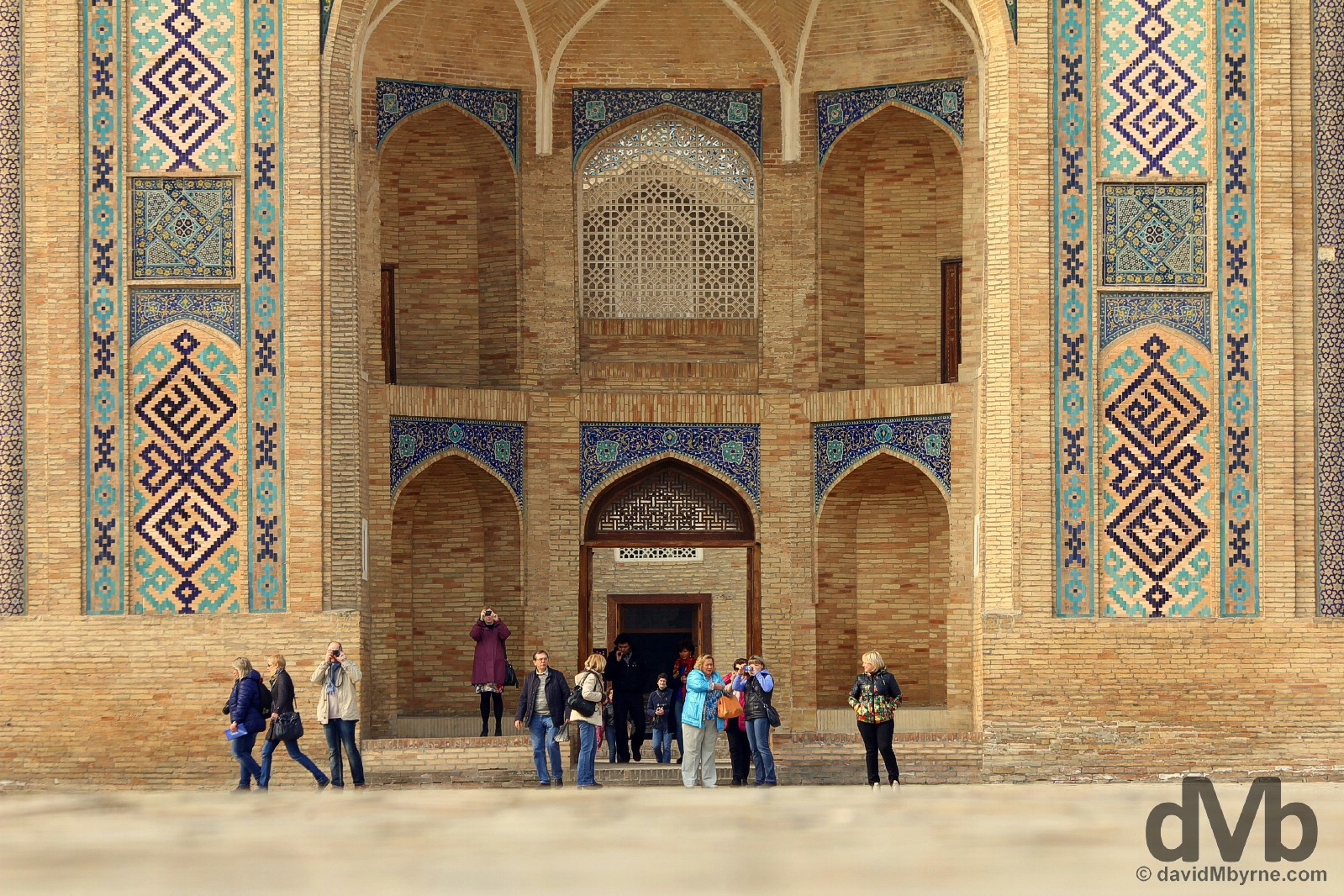
A portion of the facade of Barak Khan Medressa in Khast Imon, the less polished old town of Tashkent. While I’d seen many in Morocco, this was to be my first look at an Uzbek medressa, an Islamic school or college. At the time I thought it was impressive (& it is) but it pales in comparison to the numerous medressas I was to see over the subsequent days in Samarkand, Bukhara & Khiva. I just didn’t know it at the time. Tashkent, Uzbekistan. March 6, 2015.
DEPARTURE – A Central Asian Thumbs Up!
A Central Asian Thumbs Up
It’s late on March 17th, St Patrick’s Day for 2015. It’s my last night in Central Asia. I’ve a stupid o’clock flight in the morning to Tbilisi, Georgia, that will bring an end to my 33-night odyssey in the region having crossed over into Kazakhstan from western China on February 12th last. It has been an amazing trip, the highlights of which have without doubt been the region’s warm & hospitable people & its diverse architecture, everything from the Soviet-era monstrosities that still dot (& some say blight) the region, to the futuristic creations spouting from the steppes in Kazakhstan, to the unique, audacious & crumbling Islamic showstoppers of Uzbekistan. The weather has, for the most part, been great too. Aside from a few dull days in Almaty & the -40C temperatures Astana, my first 2 stops in the region & both in Kazakhstan, it has been mild & gloriously bright meaning my backpack has been larger than it should have been carrying mostly surplus to requirement winter heavies. Yes, the disappointment of not getting to both Turkmenistan & Iran took a small bit of sheen off the whole trip but not overly so. I’ll eventually get around to pictorially summarising the trip (that’s going to be fun) but for now this is me signing off from, & giving a big thumbs up to, Central Asia.
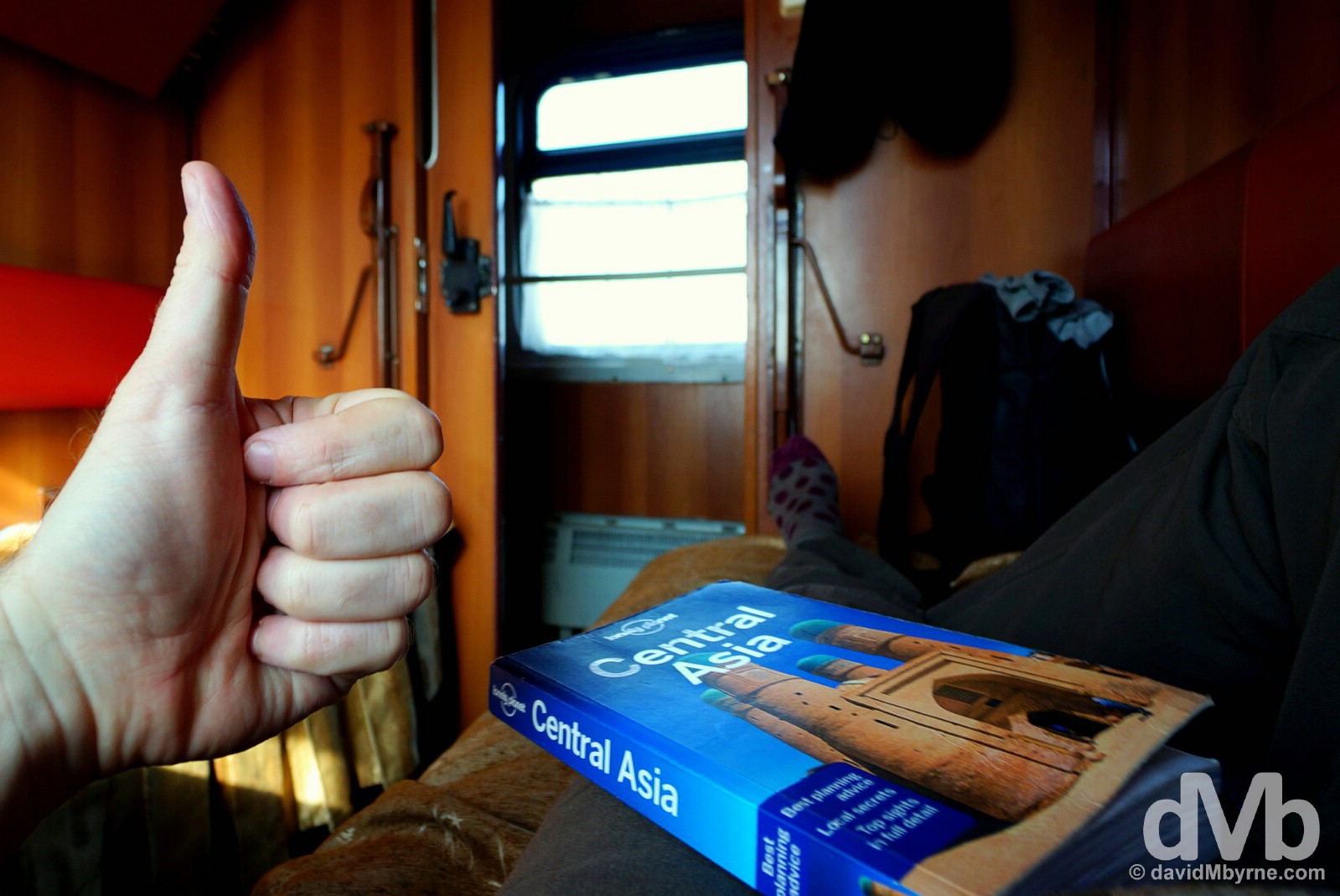
It’s a big thumbs from me to Central Asia on the well-worn but cozy overnight train from Urgench to Tashkent, Uzbekistan. March 17, 2015.
